Photo
Another repost to remember our Lt. Leslie

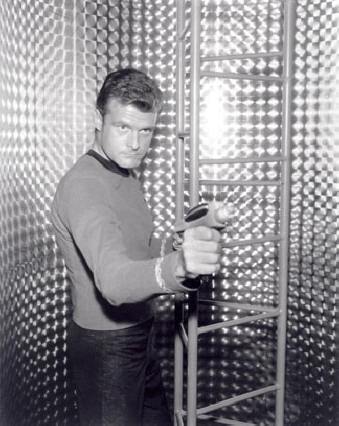

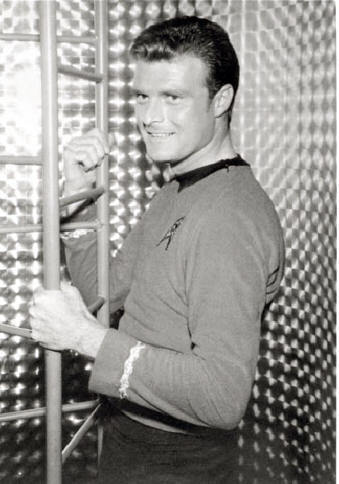
Four early publicity photos of Eddie Paskey as Lt. Leslie. There do not seem to be any publicity photos for other regular crew members such as Lt. Hadley (Billy Blackburn). Is it possible Lt. Leslie was at one time to have a bigger role or did his friendship with the production crew somehow gain him this bonus?
46 notes
·
View notes
Photo
It has come to our attention that Eddie Paskey died this past Tuesday. Most of us TOS fans know his most common role was that of Lt. Leslie but he was a man of many characters... and uniforms. In tribute, I would like to repost this article that shows just how versatile he was.
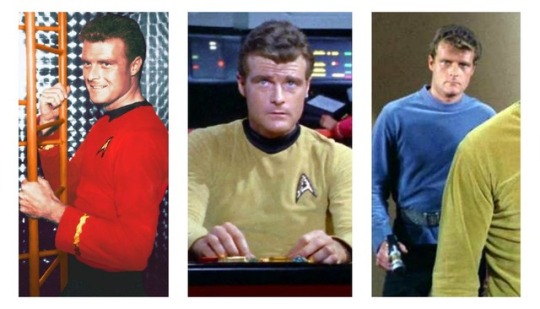
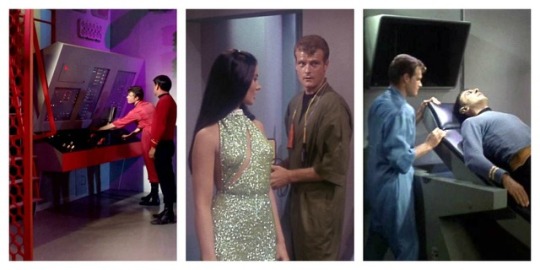
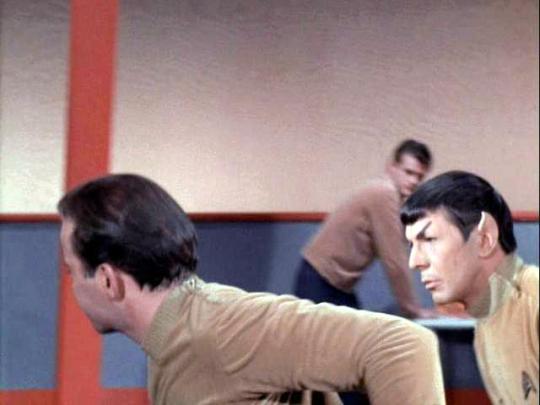
The many tunics of Eddie Paskey plus the corresponding jumpsuits. Plus an additional appearance as a background crew member in the beige tunic used in “Where No Man Has Gone Before.”
195 notes
·
View notes
Photo

As mentioned in our previous article, our Transportation Assistant Ensign Wilson was played by Garland Lee Thompson, Sr. He was born in 1938 in Muskogee, Oklahoma but his family moved to Portland, Oregon when he was seven. It was during high school there that he discovered his love of theater and dance. At age 20, he moved to Los Angeles. His first movie part was that of a ceremonial dancer in the Roger and Hammerstein movie, South Pacific.
His dual talents in theater and dance paid off when he landed the part of Wilson in “The Enemy Within.” According to his son, Garland Thompson, Jr., there was no stuntman coordinator to block out the moves Thompson and Shatner would have to make during the fight scene between the two of them. Luckily, William Shatner had also studied dancing and the two of them went into a corner and choreographed the movements. By the time they were finished, the filming crew was ready to roll. Shatner and Thompson hit their marks perfectly, the scene was all done in one take, and the focus puller declared the film gate was clean. Which thrilled the crew because that meant everyone could eat an early lunch.
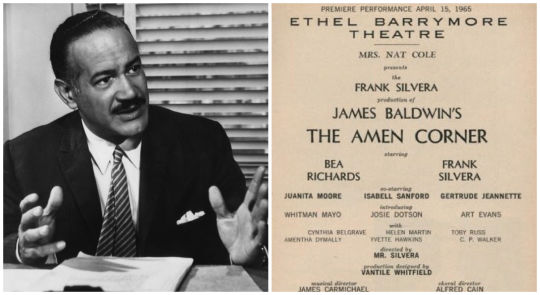
Garland Thompson performed on other television shows of the 60s such as The Lieutenant, Perry Mason and Bewitched. But he always preferred working on the stage. Even while he was on stage or before the camera, he still attended acting classes at various conservatories and workshops. The most influential of these was Frank Silvera’s Theatre of Being Workshop. Frank Silvera was an accomplished black actor in film and on the stage (his performance as King Lear in the Shakespeare play of the same name, directed by Joseph Papp, is still considered one of the best). Silvera started his workshop as a way of improving racial equality in the arts by providing instruction and support for young black actors. He also helped them attain membership in the actors’ unions and he created a theater where they could perform. Garland Thompson gave full credit to Silvera for helping him attain success as an actor, a playwright, and a theater producer. His mentor’s sudden death in 1970 at the age of 56 affected him deeply.
(photo on left is Frank Silvera and on the right is a playbill from one of his productions. Note the names Isabell Sanford and Whitman Mayo)
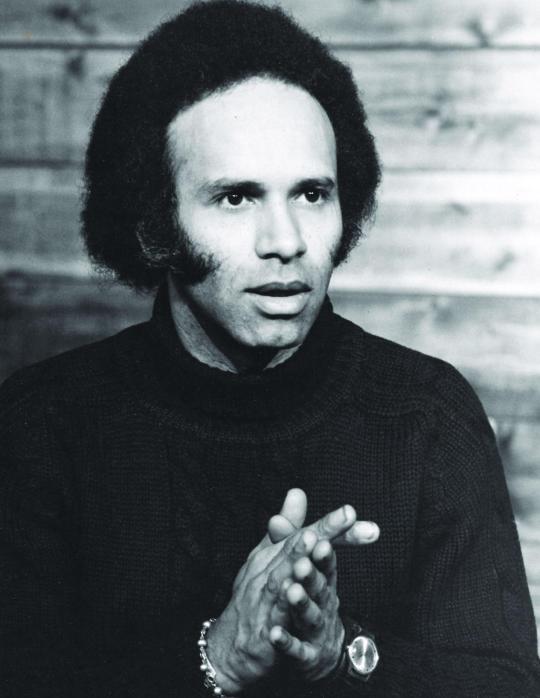
Garland was already learning his way around and behind the stage as well as in front of it. He had served as the stage manager for Ray Bradbury’s plays in L.A. but then moved to New York to be the original stage manager and associate director for No Place to be Somebody by Charles Gordone on its first national tour as well as twice more during its run on Broadway. He also began to dabble in writing plays. This led him to realize how hard it was for black playwrights to have their plays produced.
As a result, Garland Thompson decided to join actor/director Morgan Freeman, actress/director Billie Allen Henderson, and journalist/ theater critic to form the Frank Silvera’s Writers’ Workshop as a testament to his mentor and as a place for people of color to develop their play writing skills. He also served as its Executive Director. Within weeks, Garland was leading Monday night readings (and later Saturday night readings) along with critical discussions at the Martinique Theater in New York, one of many theaters that housed the Frank Silvera’s Writers workshop over the years. These readings were almost always packed. But they allowed budding playwrights a chance to hear their material read aloud for the first time and critiqued. Some rewrote their plays after the first presentation and brought them back to be read and critiqued a second time.


Over the years, around 20,000 scripts were written and read at the workshop. Thompson also helped writers get their scripts produced on stage, including Ntozake Shange’ and her award winning play For Colored Girls Who Have Consider Suicide, When the Rainbow is Enuf. Many of the students in the workshop also learned how to work backstage in largely unseen but very important duties, such as those involving lighting and sound. This gave them a more complete education in the theater arts. Garland Thompson even brought his own work in front of his students to be read and critiqued, then later produced. A playbill and a newspaper advertisement illustrate production details of two of his plays.
Many major figures in Black Theater participated in several aspects of the workshop. These included Ruby Dee, Angela Bassett, Adolph Caesar. Morgan Freeman, Debbie Allen, Aduke Aremu, Samuel L. Jackson, LaTonya Richardson-Jackson, Phylicia Rashad, and Charles Dutton.
youtube
In early 1999, Inside New York (a local TV news magazine) interviewed Mr. Thompson about the reasons he and his cofounders believed a workshop for people of color to write and produce plays was necessary. Do yourself a favor and carve yourself out some time to watch it in its entirety. This man’s charisma was amazing as was his enthusiasm for helping young people of color enter the world of theater.

During his lifetime, Mr. Thompson worked with and often headed many other organizations devoted to Black Theater and received many honors in connection with them. He was the founding board member of the Harlem Arts Alliance and also served on the Board of Directors. In addition to being one of the founding members of the FSWW, he served as its director and was President of the Board of Directors of the FSWW Foundation, Inc. in 1981.
The AUDELCO awards were created to promote "recognition, understanding, and awareness of the arts in the African-American community." Garland Thompson was given the Board of Directors Award in 1976 for superior and sustained contribution to community theater. He also earned another AUDELCO award in 1981 as the producer of Bessie Smith, Empress of the Blues. The photo above shows him along with two other recipients at the 1981 Awards. He also was the winner of the Washington D.C. One-Act Play Festival (according to the book Voices of Color) and the FSWW under his direction was awarded the Obie for playwrighting in 1989.

Garland also became involved in the National Black Theater Festival, starting with its second year. He set up and directed The Readers Theatre program, which grew and expanded over the years. He is shown above with his friend Ossie Davis, who was another major figure in Black Theater and who started the Festival’s first poetry slam in 2001.
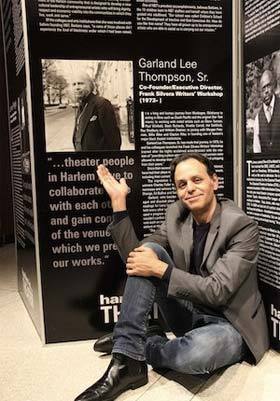
(photo credit - Lia Chang)
Unfortunately, Garland Thompson suffered a serious fall in early November 2014 which resulted in being transported to the intensive care unit at Harlem Hospital. Unfortunately, he never regained consciousness and developed pneumonia and other serious conditions. He died on the 18th at age 76.
Garland Thompson’s death was mourned by the Black Theater world. The first memorial devoted to his life and contributions was the addition of his life story to the “harlem is... Theater” Exhibition at New York’s Interchurch Center in December of 2015. Garland Lee Thompson Jr. is seen in the photo above in front of the the tribute to his father.

On February 12th of 2015, Representative Charles Rangel of New York gave a speech in front of the U.S. House of Representatives to celebrate the legacy of Garland Thompson. This speech became an official part of the Congressional Record. If you wish to read it, then click here: https://www.govinfo.gov/content/pkg/CREC-2015-02-12/html/CREC-2015-02-12-pt1-PgE208-3.htm
Instead of a traditional funeral, there was a Three Act Performance Tribute, two of which were held on February 14th, which would have been Garland’s 77th birthday. The First Act was a Memorial held at St. James Presbyterian Church. In the photo above, Garland’s son (Garland Lee Thompson, Jr.) is holding a copy of the Congressional Record containing his father’s tribute along with a photo of his father.
Act Two was a reception later that day at the Johnson Theater for the New City. Garland Lee Thompson, Jr. and Sean C. Turner hosted an afternoon of readings, poetry, and performances which ended with a celebration of Garland Sr.’s birthday.
The final act was held in August of that year during Harlem’s National Black Theatre Festival. This is where Garland created the Readers Theater so Act III was a fitting final tribute to a man who had spent over 40 years teaching, encouraging, and nurturing writers and artists of color.
His son Garland Thompson, Jr., is a noted playwright, actor, cinematographer, poet, director and producer, although he has worn many, many other hats in the arts over the years. Since 2008, he has been the Coordinator for the Poetry Out Loud recitation contest for high school students in Monterey County, California (this is part of a national contest funded by the National Endowment of the Arts) and hosts the Rubber Chicken Open Mic and Poetry Slam at the East Village Coffee Lounge in Monterey (which he co-founded 14 years ago). In 2014 he took over running his father’s Frank Silvera’s Writers’ Workshop in New York.
#Star Trek TOS#Redshirt#Garland Lee Thompson#Frank#Silvera's Writer Workshop#National Black Theater Festival#The Readers Theatre#Ensign Wilson
8 notes
·
View notes
Photo
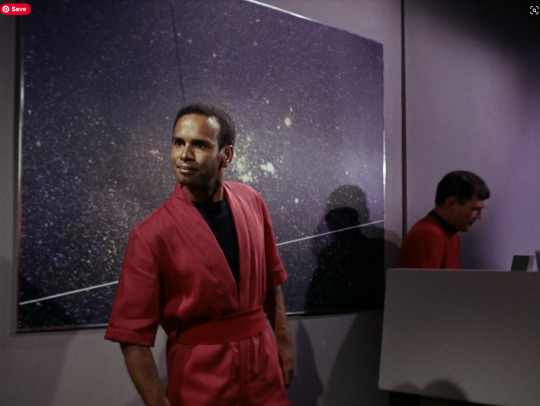
First of a two part article - second part to be posted Sunday.
Technicians on Star Trek are rarely seen in the episode for very long. Usually one or more of them appear in the hallway, ascending or descending from Jefferies Tubes or under consoles, working on some unknown components. You are barely aware of them.
But the handsome gentleman in this photo is one of the rare ones. We see him in more than one scene for an extended amount of time and he even gets in a fight with his Captain (well, one side of his Captain anyway) in “The Enemy Within.” Later he assists when a test is run on the transporter in an attempt to see if they can reunite the two sides of the original horned dog.
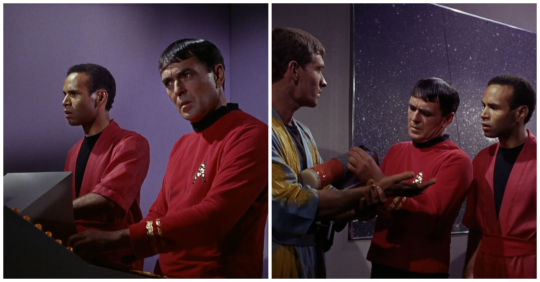
We first see Ensign Wilson in the Transporter Room working with Scotty as they attempt to bring in the injured Geological Technician. Fisher begins to materialize and then fades out. Scotty makes some adjustments with Wilson's assistance as they attempt to bring him in the second time. This time, Fisher fully materializes but both men notice he is covered in a yellow powder. After examination, Scotty theorizes the powder is from a magnetic ore which most likely caused the transporter problem. He sends Fisher to Sickbay and then tells Wilson to go find an instrument so they can double-check the transporter. Once Wilson leaves, Scotty attempts to beam up Captain Kirk, but has the same problem he did with Fisher. This time, when the captain steps off the platform, he begins to feel dizzy and Scotty leads him out of the room to head to Sickbay. Ensign Wilson has evidently impressed Mr. Scott enough in the past that he can reassure the captain that his Transporter Assistant will be back momentarily.
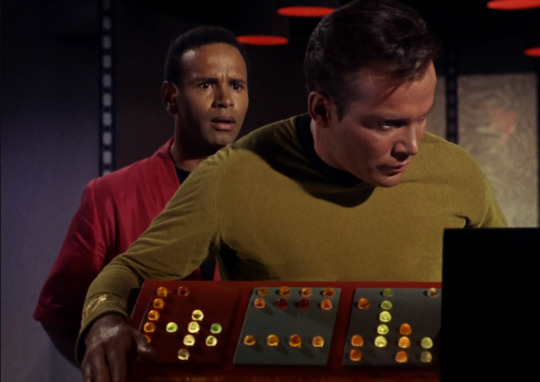
What Scotty did not realize was that in that short period of time after everyone left, another Kirk has appeared. When Wilson re-enters the room, he is concerned to see the man he thinks is his captain acting a bit disoriented and offers to help. But this Kirk looks at him strangely and abruptly heads out the door, leaving Wilson quite puzzled.
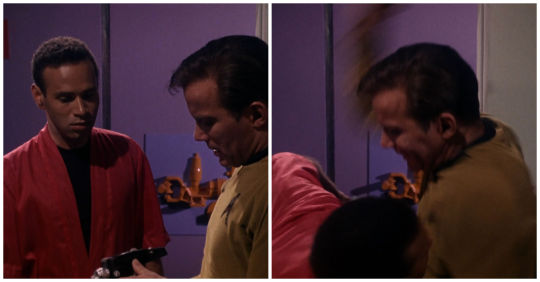
Fast forward several scenes and Ensign Wilson appears again. Evil Kirk has just applied makeup to his face to cover the scratches which will identify him to the crew per Good Kirk's announcement. He has just set foot in the outside corridor when he sees Wilson and orders him to turn over his phaser. The ensign, still not suspecting this is the imposter, complies. Evil Kirk then attacks Wilson and leaves him unconscious on the floor while he escapes to find another place to hide.
FYI - There's more involved in setting up this scene than meets the eye. Be sure to look for the follow-up article on Sunday.

Luckily, our transporter assistant is not seriously injured and is able to help Spock bring the two horned dogs, one evil and one good just like Kirk, to the transporter pad. Unfortunately, when Scotty sends both dogs down and then tries to bring them back, there is only one dog but it is dead. Spock convinces Jim to attempt bringing his two halves back together anyway and fortunately Kirk's intelligence allows the transporter to bring the two halves back as one Captain Kirk, fully recovered. The rest of the landing party on Alpha 177 is rescued before they have fully succumbed to the freezing temperatures.
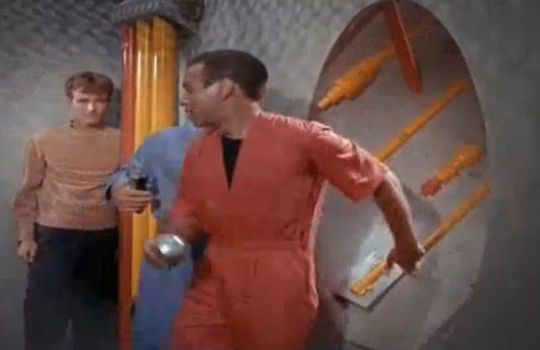
Interestingly, we had seen a character who looked exactly like Wilson in an earlier episode, "Charlie X." That's because an actor named Garland Lee Thompson played both Transporter Assistant Ensign Wilson and the technician here (referred to in the credits as Crewman II).
Garland Thompson never appeared on many TV shows or films. But he did leave a huge mark on the world of Black Theater. Look for the second part of this article on Sunday when we find out just how amazingly talented and influential this man was (and still is).
29 notes
·
View notes
Photo

Don’t wait until it’s too late! Happy Redshirt Valentine’s Day!
23 notes
·
View notes
Photo
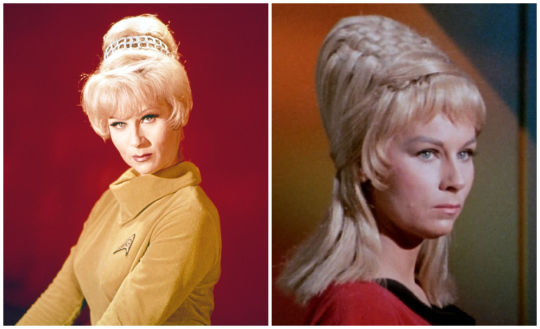
We know the first photo is an early publicity photo of Yeoman Janice Rand taken before the first season aired. And we know the second photo photo is the same Yeoman Rand wearing her signature beehive. So how did we get from the first hairstyle to the second?

Gene Roddenberry had already approved one change in Yeoman Rand’s look. Instead of the blousy top and plain black slacks worn by females in both the first and second pilot, a more fitted tunic and a short skirted uniform was designed by William Ware Theiss. But Gene also wanted a more futuristic hairstyle for Rand. So Theiss designed her signature beehive. But those are not his hands in this set of photos. So whose are they?
They belong to Virginia Darcy, who was already a well-known and respected Hollywood stylist by the time she began working for Star Trek. Darcy was the one who actually took Theiss’s design and created the wig itself that she meticulously put on Grace Lee Whitney’s head every morning and adjusted it into place.
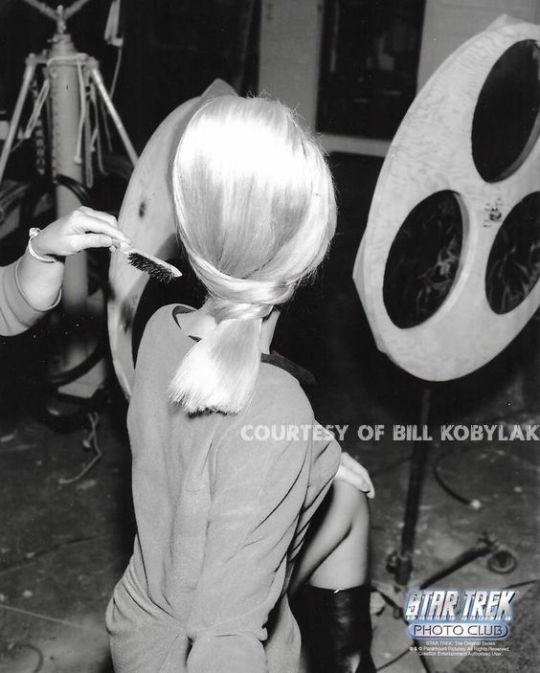
According to Whitney, the wig was created from two Max Factor wigs placed over a cone and woven together. Naturally, it was very heavy. Grace claimed it had to be nailed into place every morning to keep it from shifting when she moved.
Virginia Darcy became one of Grace’s closest friends according to her autobiography, The Longest Trek: My Tour of the Galaxy. Virginia would dish up the gossip from the days of when she was the hair stylist for Ester Williams on the set of the movie musicals in which Williams would display her swimming skills. However, Ms. Darcy’s stories often had Grace in stitches and that would set them both off laughing even more loudly. The sound evidently carried from the dressing room onto the nearby set and A.D. Greg Peters would often storm in angrily, telling them to tone it down because they had just ruined another of his takes.
*Special thanks to Billy Kobylak for letting me post these two rare photos. The back of Rand’s head was something you rarely saw in this much detail.
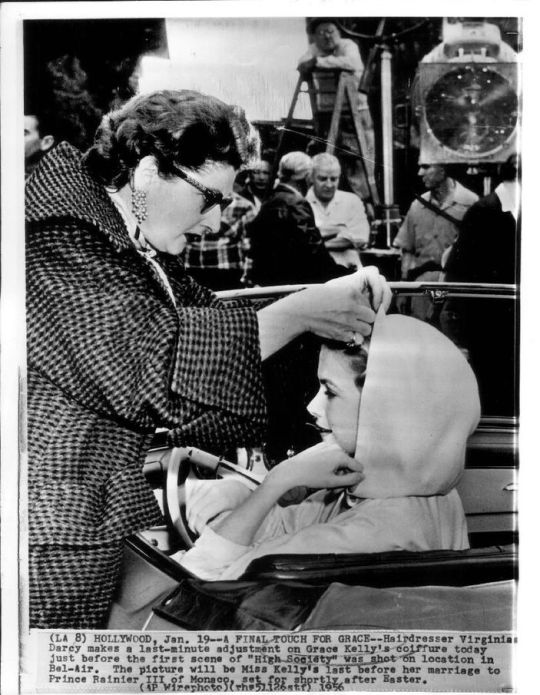
Indeed if you had asked anyone she had ever worked with on a Hollywood set, he or she would likely have told you that Virginia Darcy loved to laugh and was known for keeping things lively. Yet she was very disciplined and a perfectionist when it came to her craft.
By the time Virginia was hired for Star Trek’s first season, she had already accumulated quite a resume. Starting off as an apprentice in the major studios such as MGM, Universal, and Fox, she joined the Make-up and Hair Stylist Guild in 1947. Ms. Darcy was credited (and sometimes uncredited) with working on a number of Alfred Hitchcock films such The Man Who Knew Too Much, The Birds, and Marnie (she remained good friends with Tippi Hedren right up until her death in 2018). She was also a stylist for fourteen episodes of The Alfred Hitchcock Hour. That wasn’t all. Darcy had worked in movies such as Miracle on 34th Street and Cape Fear and in quite a number of popular television shows including The Munsters, McHale’s Navy, and Wagon Train.
Virginia Darcy only worked as a hair stylist with Star Trek for one season, but her career continued. She served as a hair stylist in Funny Girl and Funny Lady as well as Kung Fu and The Dukes of Hazzard among others. In 1985, Virginia and two others were nominated for an Emmy for their work on the mini-series North and South. Shortly afterwards, she retired but kept in touch with her many friends and colleagues. Ms. Darcy died at age 98.
Now why would we go to so much trouble to spotlight a person who has what one would think is a minor position? Ms. Darcy wasn’t just any hair stylist. She had a stellar reputation before she was hired for Star Trek. And those hair styles, especially that of Yeoman Janice Rand’s, helped create the illusion we were watching the future unfold before us every bit as much as Theiss’s costumes, Matt Jefferies’ spaceships, or Wah Chang’s props. She is another example of Gene’s intention of hiring the very best people for his new show.
214 notes
·
View notes
Photo

Remember this fellow? The redshirt we spoke of earlier who had tried to turn his life around but instead wound up not only as one of Chekov’s henchmen in the Mirror Universe as well as a Klingon soldier? Actually, he was played by an actor by the name of Bobby Bass who is considered one of the best stuntmen Hollywood ever produced. He appeared in at least 91 TV shows and movies as a stuntman (and occasionally the stunt coordinator as well) and 32 as an actor.

Bobby Bass was a native Californian, born in 1936. He showed an early interest in martial arts and competed in judo tournaments as a teenager. Bobby caught the attention of Gene LeBell, a martial arts instructor and Hollywood stuntman who encouraged him to continue his judo instruction. He later introduced Bass into the stunt industry.
After serving as a paratrooper with the 82nd Airborne Division, Bobby Bass became a Green Beret and a Special Forces instructor. He still kept up his judo training, attaining his third degree black belt in 1960 at Fort Bragg. Once he left the military and became a production supervisor for a factory in Los Angeles, he continued to practice at the Seinan Doju under the leadership of Kenneth Kuniyuki.
The photo above is an illustration taken from the January 1962 magazine titled Black Belt. Bobby Bass is assisting Judo champion and instructor Dave Chow in a demonstration of Changing Techniques and Counter-Throws.
But let’s move on to his Hollywood career.
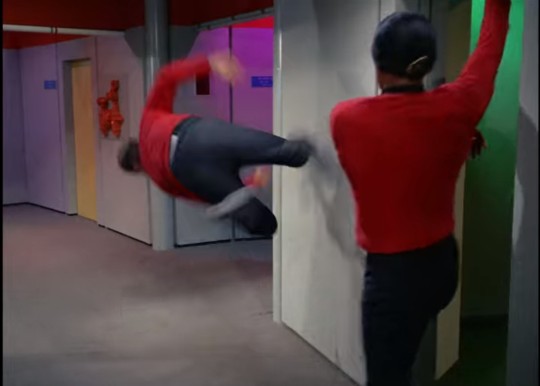
As mentioned, Gene LeBell introduced Bobby to the stuntman industry. And his first acting/stuntman gig was with Star Trek. He was given roles in five episodes - several as guards or other crewmen, and once as a Klingon. In some of those, his knowledge of stuntwork came in handy as in the above scene from “Space Seed.” In at least two episodes (and likely more), Bass was James Doohan’s stunt double in “Catspaw” and “The City on the Edge of Forever.”
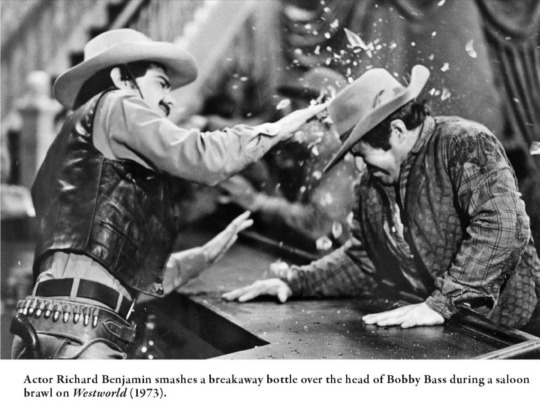
After that, Bobby Bass was hired as a stuntman/actor in a number of films and TV shows. Right after Star Trek, he had an uncredited stuntman appearance in The Green Berets, in which George Takei had a guest role.

Hal Needham hired Bobby Bass as Jackie Gleason’s stunt double and driver for Smokey and the Bandit. That was Bobby Bass in Sheriff Buford T. Justice’s seat as it slid under the beam and had its roof sheered off.
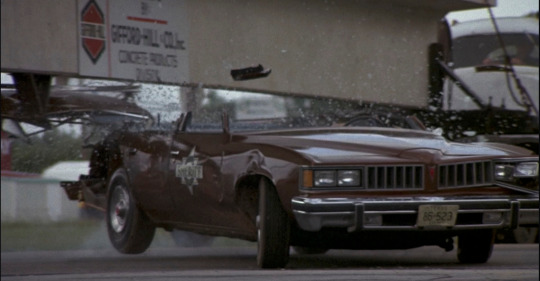
Bass was able to keep control of the car even though he had to duck way down to avoid having his head sheered off too. Now that’s some fine stunt driving. Burt Reynolds was so impressed with Bobby’s work, he made sure to hire him for many of his later films.
Stunts Unlimited posted an example of one of Bass’s driving stunts in Hooper, another Burt Reynolds movie: https://www.facebook.com/125376856964/videos/10155312719931965/
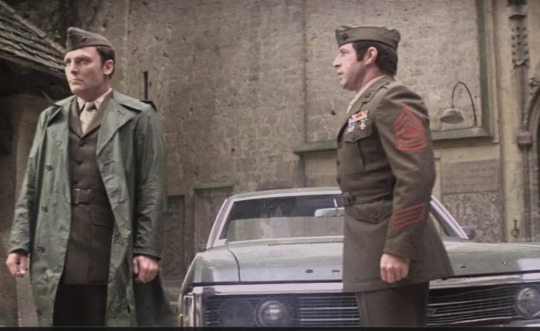
He was hired again as a driver in The Ninth Configuration. Bass was always a desirable hire for stunts involving almost anything, but his specialties seem to be stunt driving, armed combat and martial arts, and use of special military style weaponry.
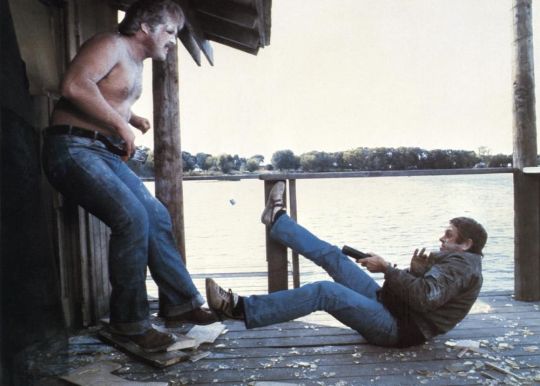
A fight scene in The Hunter - which one is Bobby? My guess would be the shirtless fellow on the left because of the body build. By this time, Bass was beginning to be hired as the stunt coordinator for many movies and films. Not only was he the stunt coordinator in this film, but for Hooper, The Cannonball Run, Lethal Weapon and Lethal Weapon 3, and Excessive Force, among others. Bobby was also one of the first stunt coordinators on the original ABC and CBS “movies of the week.”
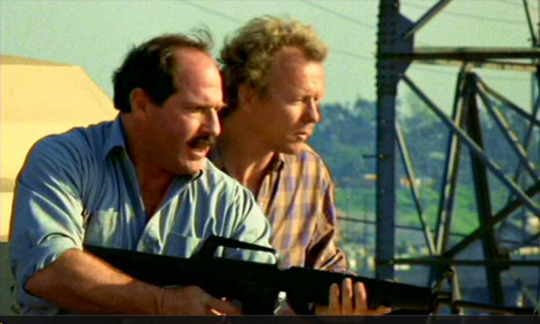
Bass also got to show off his weapons handling skills in movies as well. In To Live and Die in L.A., he plays an FBI agent who appears quite at ease handling an assault rifle. As the stunt coordinator in charge of Lethal Weapon, he was the one who gave Mel Gibson the special weapons training he needed for the film. He also taught him his own signature “head butt” technique as well as other barroom brawl moves . Bass taught the same head butt move to Michael Douglass for his scene in Black Rain where Douglas had to battle some Japanese thugs. After that, the head butt began showing up in a number of action films. Bobby Bass taught both weapons handling and fighting techniques to Geena Davis, Susan Sarandon, Kathleen Turner, Burt Reynolds and Danny Glover.

Unfortunately, he was the stunt coordinator in a movie that left his fiancée at the time, stuntwoman Heidi von Beltz, a paraplegic. Bobby called her and asked her to come to the desert set of Cannonball Run. She was to be Farrah Fawcett’s stunt double for one scene as a passenger in the front seat of an Aston Martin that wove in and out of a line of oncoming cars moving at a high rate of speed. But there were a number of serious problems with that Aston Martin on the morning of the shoot. The tires were bald, there were no seatbelts, it had defective steering and its clutch was malfunctioning. Another car had to push it to help get it started and even then, it wouldn’t go any faster than 8 mph.
Director Hal Needham did have a mechanic work on it for a while. Bobby Bass assured Heidi the car was fine after he took it for a test run. Yet the stunt driver assigned to the car still did not think it was ready. He was told to do the best he could because the parts needed would not arrive in time.
Heidi remembers hearing a voice on a walkie talkie in the car repeatedly tell the driver to go faster. Seconds later, the Aston Martin slammed into one of the oncoming cars and she was thrown into the windshield. By the time the crew pulled her out of the car, her neck was crushed.
Melvin Belli successfully filed a lawsuit on her behalf against Stuntman, Inc., Hal Needham’s company which supplied the stuntmen needed for the film. Bobby Bass, who had left her after the crash, testified that they thought the car was safe but he also had to admit the Aston Martin was the only car in that scene without seat belts. He said it would have only taken 15 minutes to put them in.
Ironically, after this incident and the horrific accident on the set of The Twilight Zone: The Movie a few years later, Bass was one of many stunt coordinators who fought for safer working conditions for stunt people.

Bass’s name turned up in an ugly incident near the end of his life. During the investigation into the murder of actor Robert Blake’s second wife, Bonnie Bakley, police affidavits reveal that an informant claimed Blake had contacted several stuntmen for a hit job. Two of those, Gary McLarty and Ronald Hambleton were interviewed by police and they both stated they were solicited by Blake to commit the murder, but each turned him down.
Blake also tried to reach Bobby Bass, according to the affidavits. The actor wanted to contact him primarily because it was Bass who had instructed O.J. Simpson on how to use a knife for the movie Frogman. But Bobby Bass told police he declined to meet Blake because he was suffering from Parkinson's disease. Sadly, the disease took his life later that year. (He did not commit suicide, despite what several other sites have claimed)
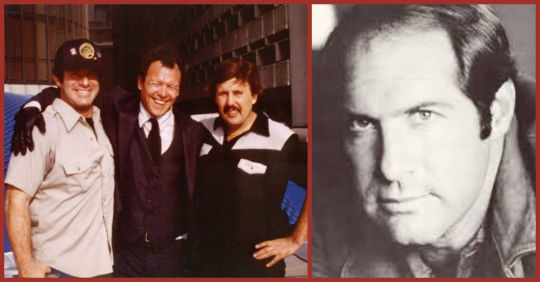
But we don’t want to leave Bobby’s image on a negative note. If it weren’t for Bass and other stuntmen like him, we would not be able to experience movie thrills vicariously as we do when we watch films such as Smokey and the Bandit, Cannonball Run, and Lethal Weapon. How could anyone watch that scene in Smokey and the Bandit where he drives the sheriff’s car and stays with it as its roof gets sheered off by a steel beam and not be impressed? Or this ending to Hooper, which he not only coordinated but in which he also performed as one of the stunt drivers?
https://www.facebook.com/125376856964/videos/10155405518461965/
By the way, take a look at all the stunt drivers involved in this scene and see how many Star Trek stunt doubles and extras you can find.
Let’s end with a statement given by his step-daughter, Bo Derek, to the Associated Press after the announcement of his death at age 65:
He was a remarkable man. He’s an absolute legend in this business. Everyone revered him.
8 notes
·
View notes
Photo
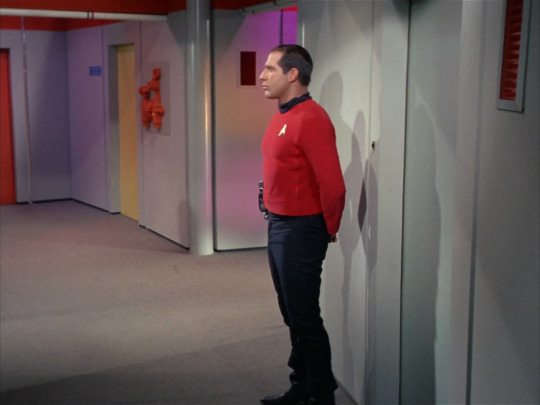
Today, we tell you the sad story of a redshirt who lost his way and wound up on the wrong side of Starfleet and the Federation. But first, a warning that the following story is fictional and any resemblance to the star dates or production order of the episodes are highly unlikely. Just sit back and enjoy
Our redshirt is a typical security guard. Steely eyes. Military stance. Perfect choice to stand outside Khan's quarters in "Space Seed," right?
But something odd happened just before this.
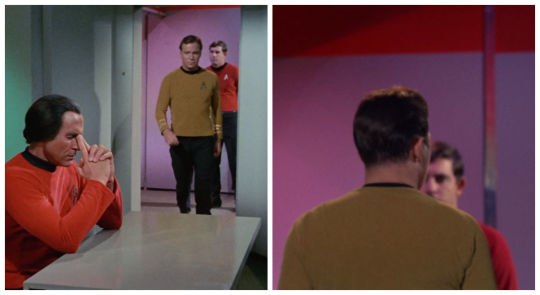
He's not the same security guard who was outside Khan's door when Kirk first enters Khan's quarters. Different build. Different hair. No wide part.
Even when Kirk gets ready to leave, the same young man is there in the same exact place. Which means he should have been the same security guard in the next frame.

Except he isn't. Somehow a completely different security guard is in the young redshirt's place. There's no way a shift change could have occurred between the time Kirk opens the door and the time he has exited it. So what happened?
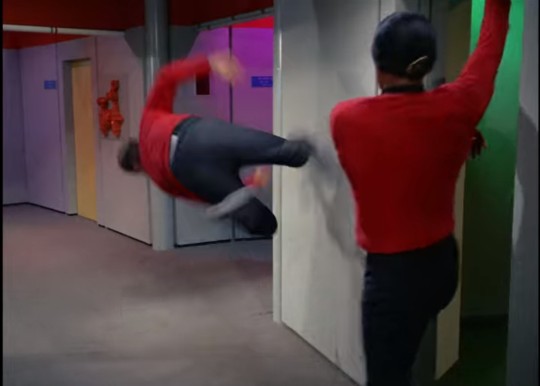
To answer this, we need to leave our fictional world a second. Most likely the switch was made because this scene calls for an experienced fall guy. If you are going to get thrown down the hallway by Khan, you have to be able to pull off an acrobatic midair dive for the camera. So a switch was made and a stuntman replaced the first guard. It is this new redshirt who is the main focus of our story. So let us continue...
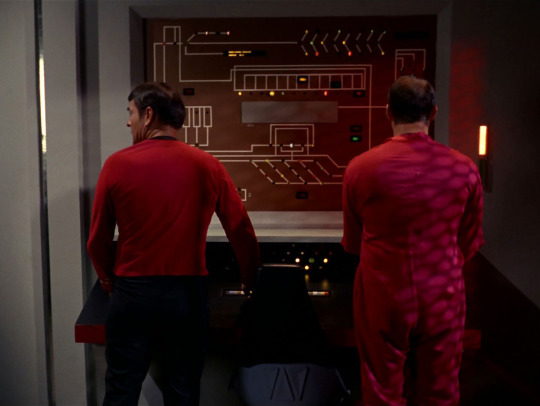
We see our acrobatic redshirt again in “I, Mudd.” Here he is, standing to the right of Scott in engineering. So obviously, he has changed assignments but still is in the same division since he is still wearing red. Maybe he thinks he's a bit safer down in the engineering room.
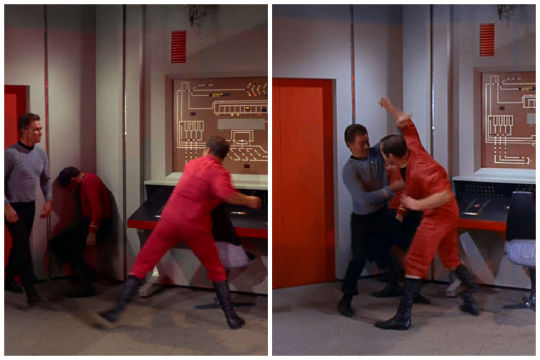
Except he'd be wrong. Engineering is probably not the safest place to be. In any case, at least he has lost none of his security guard training. When Norman has knocked out Scotty, this guy braces himself and winds back for what should have been a hell of a punch. But he is no match for Norman and gets knocked out again.
*Sidenote - obviously there's been another switcheroo and we have a different Norman here. Loren Janes was Richard Tatro’s stunt double for the engine room scene.
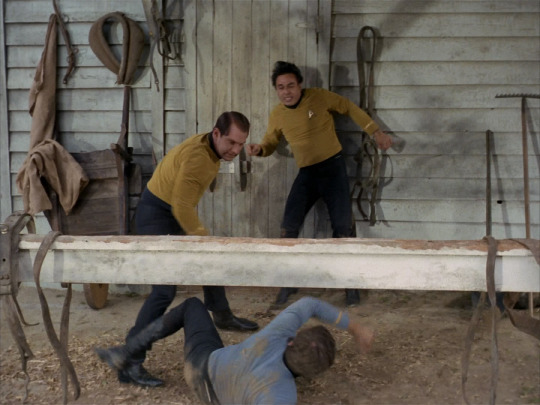
It seems our man in red finally had enough of getting knocked out as a redshirt so he asked for and received a transfer to the command division, where he even earned a promotion to lieutenant. But even as a goldshirt, he still seems to find trouble. Under the influence of the gas Kirk and Spock introduce into the the atmosphere in this scene from “This Side of Paradise,” he tries to take on two other lieutenants at once.

In the Mirror Universe, our lieutenant is a bit more dangerous and has an even stronger pugilistic tendency. We see him as one of Chekov’s guards attacking Captain Kirk in the turbolift on Chekov’s orders.
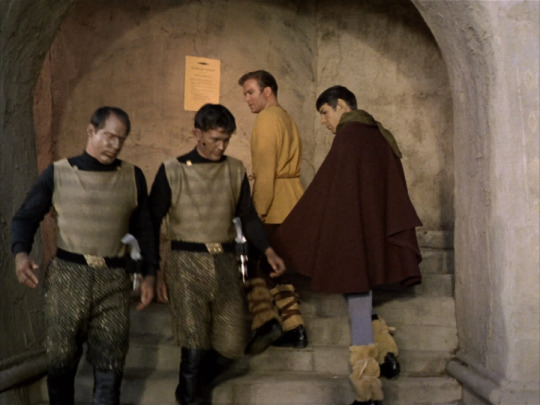
And the evil side of him we saw in the Mirror Universe now begins to emerge in the Prime Universe. As a result, he has cosmetic surgery and becomes a Klingon. We see him here on the far left walking out as Kirk and Spock are on their way in to the Organian council chambers. Ah, our poor redshirt! The strain from all that fighting seems to have scarred him for life.
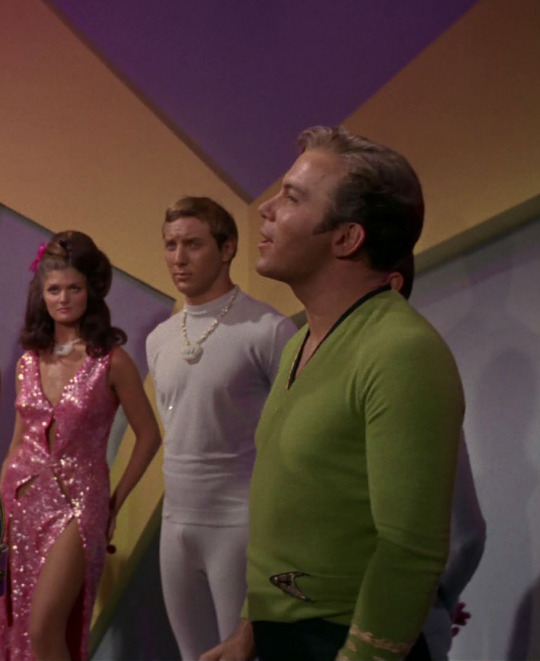
Oh, by the way. Memory Alpha seems to think this male android in “I, Mudd”, a member of the “Oscar” series, is Bobby Bass. Take a good look at his hair and body build. No way is this the same guy. Wrong build. Wrong hair. Wrong identification. But of course, this leaves us with the question of just who is this actor? Hmmm... a quest for another time.
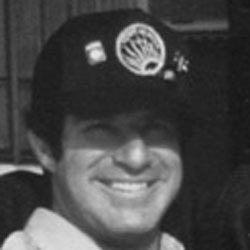
Some of you have probably realized that the redshirt with the receding hairline is Bobby Bass, who got his start both as an actor and a stuntman on Star Trek. Next week, we will discuss his background and appearances in other shows and films. And actually, he was a fascinating person with a very interesting background. See you next week with the rest of the story!
17 notes
·
View notes
Photo
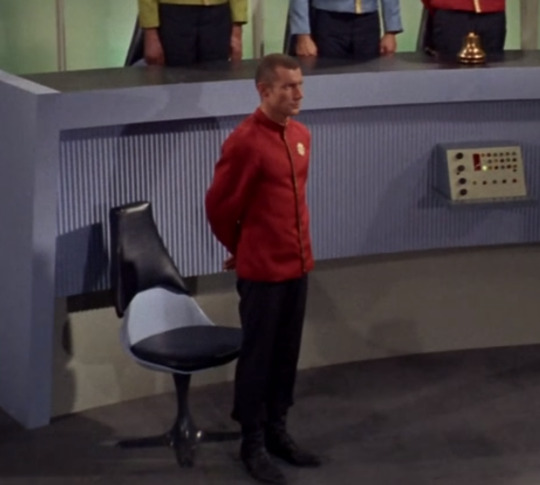
Sometimes you can watch an Original Series episode multiple times and still never notice a particular character. Even if that person appears in a number of lengthy scenes and whose actions are an important part of the story. This man in red is one of those characters. Have you ever noticed him before? Do you know what his particular duty was in the story?


According to Memory Alpha, this lieutenant who clearly was assigned to Starbase 11 was never given a specific name. On the shooting schedule, he was referred to as an aide. But in the dialog, the lieutenant was spoken of as a clerk, which more accurately describes his role.
In “Court Martial” we usually see him seated to the left of the court panel. But each time a session begins, the lieutenant must walk over to the machine and turn it on, signaling that from then on, everything is being recorded.
In many ways, his duty is more like that of a 21st century court reporter. A court reporter also uses a specialized machine to record the proceedings and produce an accurate transcript.


There is one other thing this machine can do, though. When each witness is called to testify, that person then hands the lieutenant an identity tape which he inserts into a slot. It then reads back the official description of that person, his duties, rank and assignment, and any awards he/she may have. Once his testimony is finished, then the clerk hands the tape back to that person.

It would appear we have seen a machine similar to this before. Two in fact. There is another recording device in Commodore Mendez’s office that is used when the Commodore formally charges Captain Kirk with the murder of Ben Finney. The only differences between the two seem to be in the color of the bottom panel where the sound controls and on/off button seem to be.
And we have actually seen one earlier than this. During Mr. Spock’s court martial hearing during “The Menagerie, Part One” Miss Piper inserts a tape into the court recorder for the exact same reason - to play back an identity tape. There are a few differences here also. This recorder seems to stand on a pedastal and again, the colors are different. Also in this episode, the machine has labels identifying the purpose of each button on the machine. But neither machine in “Court Martial” has any such labels. Why didn’t the labels carry over?
Remember the order in which episodes were aired were not the order in which they were produced. We may have seen “The Menagerie, Part One” first, but “Court Martial” was the 15th in production order and “The Menagerie, Part One” was 16th. So it’s likely that the machine in “The Menagerie, Part One” had the labels added after “Court Martial” had finished filming.


But back to our lieutenant. When the court martial panel and those involved in the proceedings move to the Enterprise, this clerk accompanies them.
He even moves with them to the bridge later. Notice he carries a tricorder with him since he no longer has access to the computer in the hearing room. Which emphasizes the importance of this lieutenant. Without an accurate record, no one else would ever be able to access the official hearing in case of questions later.
But this isn’t the only thing interesting about the lieutenant. Did you pay attention to his uniform?

I do believe this is the first time we have ever seen the dress uniform for Starfleet lieutenants. Notice the thin gold piping used instead of the thicker braid worn by commanders, executive officers, and higher-ups. Our clerk did not seem to wear the rank stripes of a lieutenant even though Lt. Areel Shaw had them on her female version of the dress uniform.
He wears the assignment badge particular to Starfleet members assigned to a starbase. That sunburst badge had been previously seen in “The Menagerie” on Commodore Mendez and Miss Piper.

(photo from Profiles in History Auction Catalog)
The only other time we see a lieutenant wearing a dress uniform is in “The Savage Curtain.” At least it’s the only other episode I could find with such a tunic. It belonged to Lt. Dickerson, chief security guard and leader of the honor guard. However, someone in costuming gave him the wrong outfit - the one above is actually what Lieutenant Commanders wore for formal occasions. And Dickerson is clearly identified in the episode as being a lieutenant. Notice Scotty standing next to him wears the exact same tunic. Although there does not appear to be that much difference between the two. The only major difference is that lieutenants wore their usual assignment badges but lieutenant commanders wore decorations instead.

Here is one other interesting bit of trivia. Remember the scene in the bar on Starbase 11? That is our clerk seen from the back holding the arm of a female crewman. And at the table on the right in the background? The young lieutenant commander in the redshirt lifting a drink to his lips has been seen in several previous episodes as Lt. Lewis. There is nothing to indicate that any crew members from the Enterprise were given shore leave, which always gave me the impression the crew members in this scene were from another ship or maybe even ships.
For years I wondered why this scene (which leads to Captain Kirk’s confrontation with members of his own Starfleet Academy class) would show the members of the court martial panel fraternizing with other crewman in the bar before Commodore Stone has even decided to convene the panel. Then I read the production information for this episode in These Are The Voyages, Season One.” It seems that the scene with Kirk and Stone were supposed to come first and the bar scene later. Supposedly, it was determined that the first scene had very little action and would not snag the interest of the audience. So it was swapped with the bar scene to improve the pace of the first act.

One final bit of trivia - unrelated to the rest of this article but interesting . Take a look at Lindstrom - the officer sitting between Portmaster Stone and Captain Chandra. Notice he is not wearing the same Starfleet regulation trousers with the flared bottoms. Even the material is not the same. And he is wearing what appears to be Klingon boots. Was his shoe size one that the wardrobe department didn’t have?
And this is a good photo to end on. You get to see the entire group of Starfleet court members and their various uniforms.
And even though we don’t know the name of the actor who played the court clerk, we can still admire the attention to detail he shows. Look at that stance - typical military pose with legs slightly apart and arms behind his back. This may be a small role, but he realizes it is still an important one in the courtroom.
And most importantly - he is a redshirt with a desk job. His chance of survival is high.
146 notes
·
View notes
Video
youtube
What does a Thomas Dolby video have to do with Star Trek? Actually for this week’s installment of From the Files of Redshirtgal, it may be entertaining to leave this playing in the background as you look at the following publicity photos taken just before the first season of TOS began.
The key here is SCIENCE!

November 19 · Edited · Remember way back, we showed the publicity photos of Kirk, Spock and Rand holding flashlights with colored lenses and remarked this was because none of the props we are used to seeing on the show were ready yet. There are several other sets of photos taken around the same time. One of them features Mr. Spock holding several weird looking tubes and flasks. They were meant to emphasize Spock’s role as the First Science Officer.
Actually all these tubes are related to the chemical process of condensation and distillation. Some of you out there probably know the exact names of each one. The ones above are ones you commonly see autographed by Leonard Nimoy.
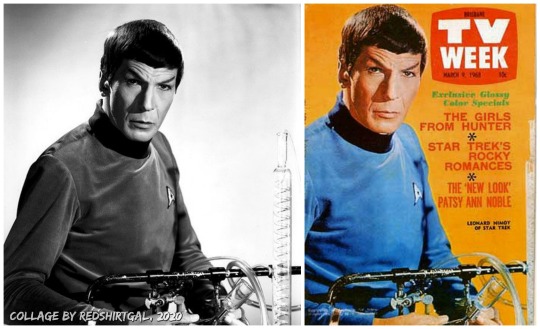
But other photos in this series show Spock holding varying types of condensation equipment. A few of these items are seen in several formats, like the one above. First you see the black and white publicity photo. It also appeared on the cover of TV Week in March of 1968. In this pose, it almost appears as if Mr. Spock is holding a weapon, doesn’t it?
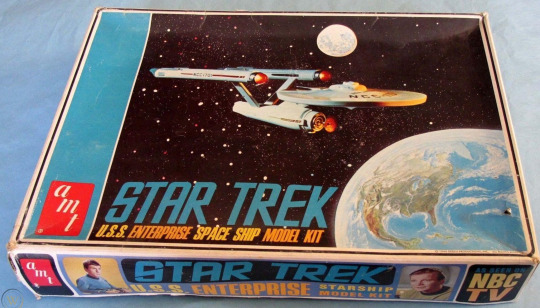
And the same photo was also featured on the side of the first AMT model of the U.S.S. Enterprise.
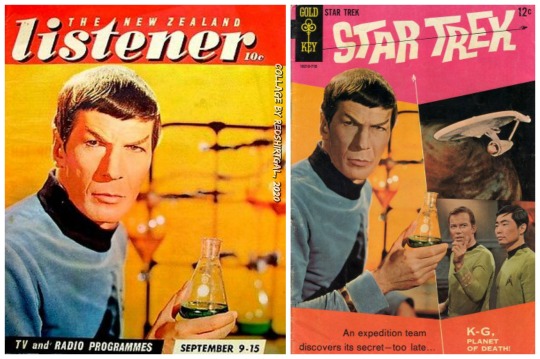
I have not seen the black and white publicity photo that were used for these two items, yet it clearly belongs to this series. Nevertheless, it seems to have made its way to both the cover of a New Zealand TV/radio program guide and to the cover of the first Gold Key Star Trek comic.
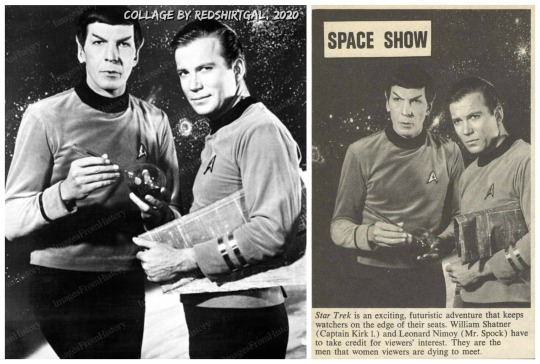
Here is one featuring both Captain Kirk with what is probably a star chart and Mr. Spock with another flask/tube of some sort. I have yet to find the source of the clipping in the second photo, but included it because it is a variation of the first pose. And yes, there are more publicity photos of the Captain with other items suggestive of his role on the new show. Look for those in the future.
15 notes
·
View notes
Photo

This article is going to stray off the usual Redshirt/ TOS extras topic a bit. I ran across the basic info while researching someone else and realized this was just too good not to share.
Take a good look at this October 1967 TV Guide article. Most Trek fans know there were at least five female android series in "I, Mudd" and that three sets of identical twins were used to represent certain series. But most people either don't realize or don't pay attention to the fact there was a male set of twins used to represent the Herman series in the episode. They were usually seen in the background, guarding doorways or seen behind the shoulders of the main characters.
Their names were Tom and Ted Le Garde and chances are, you have never heard of them before. But it turns out they were quite well known in some areas of the world by the time they appeared on Star Trek.
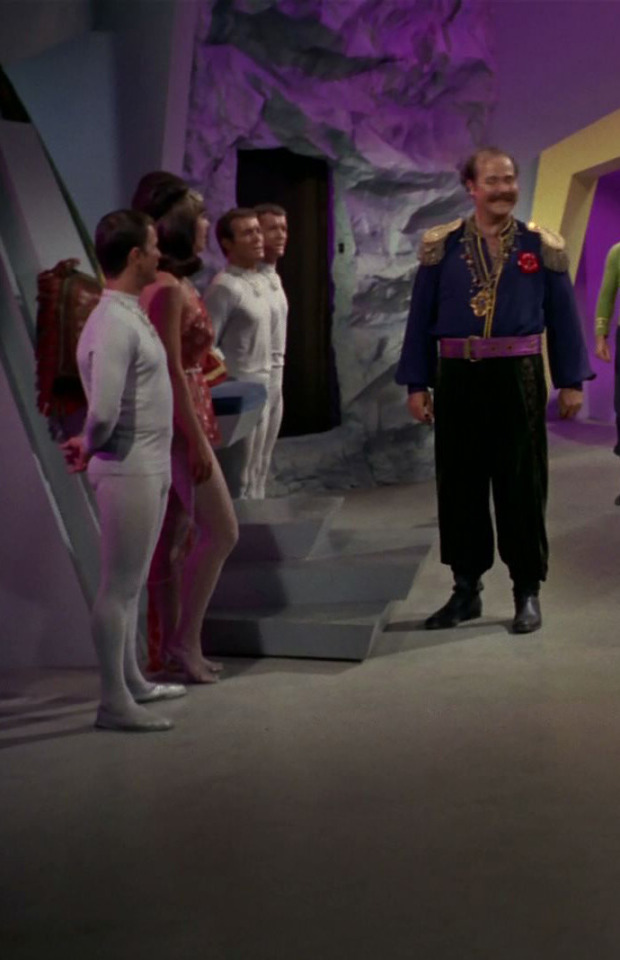
(Billy Blackburn was also a member of the Herman series of androids but notice he was placed in the forefront and the twins were placed farther back so you would not notice they really do not look all that similar)
Even though Tom and Ted were primarily known as country western singers from Australia, they had been encouraged by their manager to take acting lessons. During the 60s, the twins came to the U.S. to seek their fame and fortune. By chance, the Le Gardes were appearing in Los Angeles in an off-Broadway production of THE WORLD OF CARL SANDBURG. William Shatner was a friend of the director and producer, Ed Ludlum, and he was there in attendance on opening night. After the show was over, Shatner came backstage and chatted a bit with them. Eventually, he told them about an opportunity on an upcoming Star Trek episode called "I, Mudd" to play twin androids and asked if they were interested. And of course they were!

They believed their connection with Shatner and Ludlum proved useful when they landed their next role as a pair of river bandits in an episode of Daniel Boone titled "Sidewinder and Cherokee." The twins enjoyed keeping both Fess Parker and the guest star Forrest Tucker confused about which brother they were speaking with.
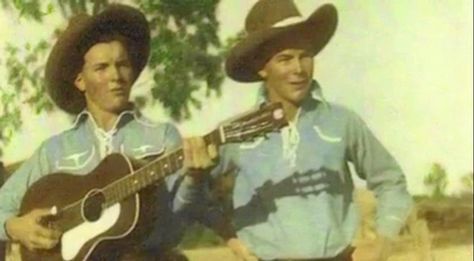
But let's back up a little bit and take a look at how the twins got their start.
When they were children, they fell in love with both country western music and cowboy movies. The first western movie they saw was one with Hopalong Cassidy, whom they would meet many years later.

Tom and Ted Le Garde eventually left the home at the age of 15 to work at one of the largest cattle ranches in Australia. Quick to learn, soon they became adept at riding horses, herding cattle, whip-cracking, and marksmanship with a rifle. But their love of music also led them into entering many singing contests while they were also participating in rodeos.
In 1947, Tom and Ted received an offer to join Buddy Williams Wild West Show. At that time, they were the youngest professional rodeo riders at the age of 17. But they were also allowed to continue singing and became popular with the audiences as Australia’s Yodeling Stockmen.
And all that hard work paid off. In 1950, Tom and Time Le Garde released their first recordings for Rodeo. And in 1952, their fortunes took off when they signed on with their first manager, Edward Samuels. He helped them refine their act, steered them toward motivational books, and had them take acting lessons. Between 1952 and 1957, they released a number of singles under the Regal Zonophone label.
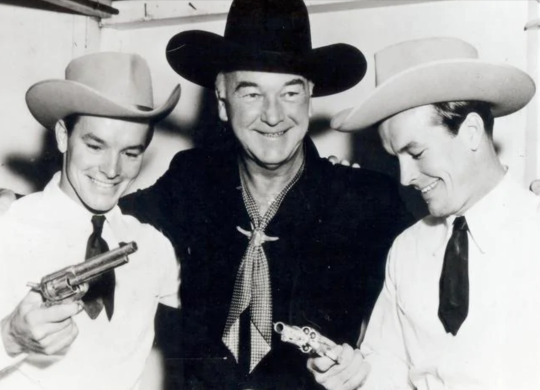
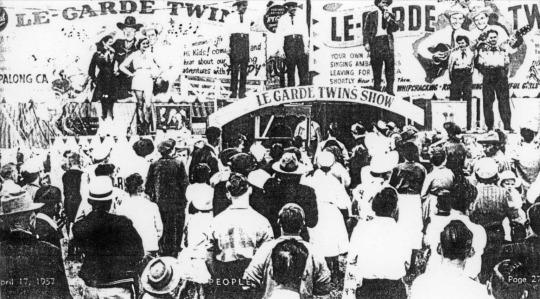
In 1954, Tom and Ted Le Garde met their idol William Boyd aka "Hopalong Cassidy" while he was on tour in Australia. That was likely the most important moment in their lives. For the rest of that tour, they were his support act. By the time they decided to try their luck in the U.S. and Canada, he had introduced them to others well known country western singers such as Roy Rodgers and Gene Autry.
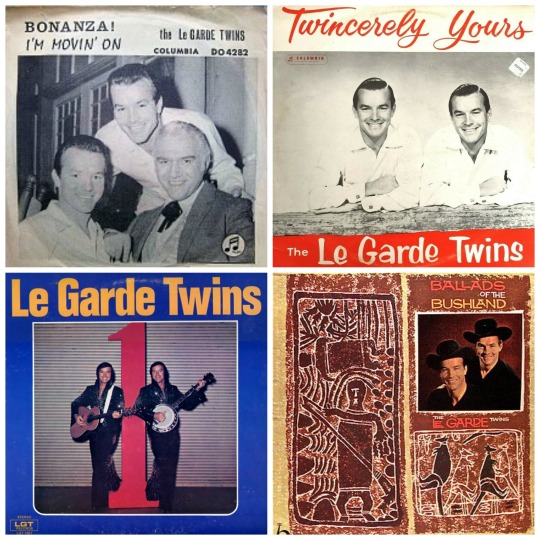
The Le Gardes were already popular recording stars in Australia before they left for the United States. They had hit singles on both the Rodeo and Regal Zonophone Records, including "Before the Dawn," There's a Bridle Hanging on the Wall," and "Nobody's Darling But Mine."
After they had finished their first American tour, they set up their own version of The Grand Ole Opry in Sydney and began recording for Columbia Records, sometimes with Lorne Green and Marty Robbins. The Le Gardes put out three albums and a string of singles.
With Gary Paxton as producer, they recorded the single "True Love" which broke into the Top 90 Country Hits. The Le Gardes had another Top 90 single with "I Can Almost Touch The Feelin'." Gary Paxton had again served as their producer. The following year, they barely made the charts with "Daddy's Makin' Records in Nashville."
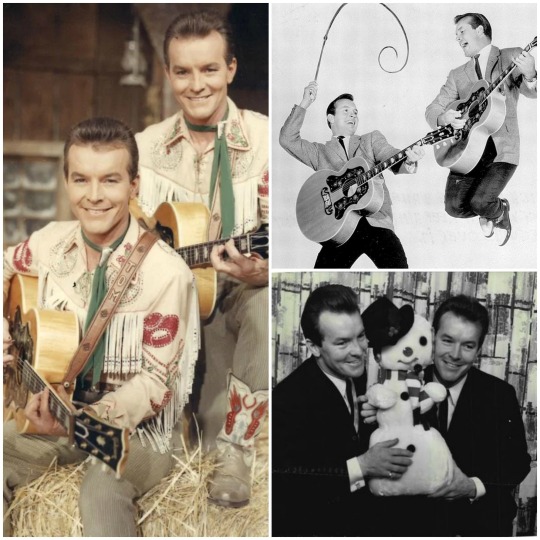
With all these recordings, naturally they began showing up on variety and talk shows in Australia, Canada, Los Angeles, Nashville, and Las Vegas as well as producing several of their own. After appearing in several shows in Canada, it was rumored they were going to have their own talk show there but it never seemed to pan out. However, back in Hollywood, the Le Gardes were seen on Doye O’Dell’s Western Varieties TV shows and hosted their own TV series on KTLA-TV Los Angeles. They made several appearances on the Grand Ole Opry in Nashville as well.
Back in Australia, they began working on their own show called "Country Style" in 1967, even filming at least one episode. However the TV studio rejected it and the episode was not aired until 2010. But the following year, they did agree to host a variety show called Studio A.
On one of their returns to the United States, Elvis Presley's manager Colonel Tom Parker helped them get a three year contract in Las Vegas which provided some stability while they continued to record.
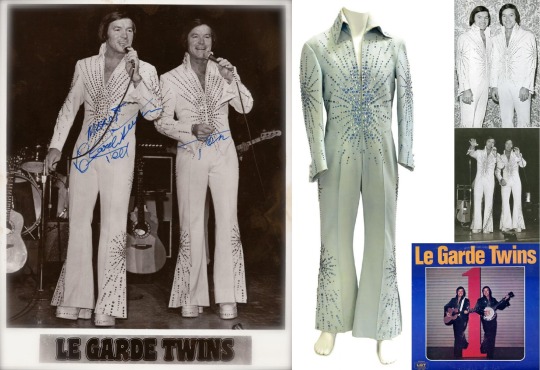
How many times have we seen a Star Trek connection to Elvis Presley? This one, however, is unique. Not only were the Le Garde twins taken under the wing of Presley's manager, Colonel Tom Parker, but they also wore variations of a very famous Elvis costume on stage. Elvis' jumpsuit was known as the "Light Blue Target Suit" and was made by Bill Belew's IC Costume Company. The white and the black versions of the Le Garde's outfits were made by the same company. No one knows if Colonel Tom Parker took them to Bill Belew's company and asked to have these jumpsuits created off the pattern for Elvis Presley's or if the Le Gardes themselves ask Parke for help in ordering the two sets. Bill Belew rarely did individual orders by the 70s so Parker had to have been involved somehow.
In the photo above, the suit in the center is a copy of the Elvis suit - the stones are a lighter blue. But you can see there are slight differences between the ones worn by the Le Gardes and this copy - the stones in the Le Gardes’ jumpsuit were spaced farther apart. If you want to see the actual Elvis outfit, you can click on this link.
https://www.tapatalk.com/groups/elvismomentsintime/13-blue-starburst-jumpsuit-t6529.html

In 1987, they were awarded Hall Of Fame status at Australia’s prestigious Tamworth Country Festival and during the 80s, they launched their own Boomerang label and made several appearances in the UK, including at the Wembley Festival. Their last US country chart entry in 1988, "Crocodile Man From Walk," reached number 92.
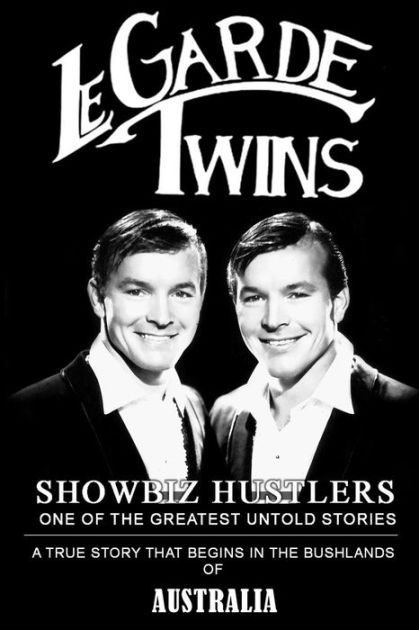
Maybe the Le Gardes never quite made it to the top level of stardom in the U.S., they still managed to enjoy quite a bit of success both there and in their home country. In 2015, they released a book about their rise to fame as Australia's first country western music export. Even though Ted Le Garde died in 2018, they are still fondly remembered by many of their countrymen. Quite an accomplishment for twin brothers we only knew as male androids in "I, Mudd."
11 notes
·
View notes
Photo
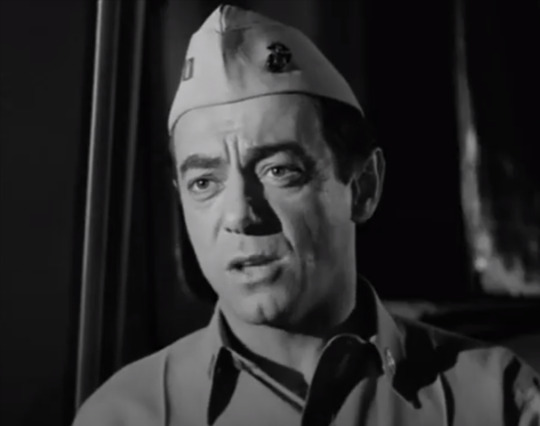
Two days ago, we discussed the sad story of Lt. D’Amato along with some interesting factoids. Now it’s time to learn about the actor who played him, Arthur Batanides. His interest in show business started during World War II when he would entertain his fellow soldiers with his comedy routines. Once the war was over, he began classes at the old Actor’s Studio. Before long, he was finding plenty of work in television and in film as a character actor. If you watch enough TV reruns from the 60s and 70s, you probably have seen Arthur Batanides in a small guest part.
Trivia - During the late 1940s, Batanides shared a rented house with Fred Freiberger while they were both taking classes at the Actor’s Studio. It was Fred who hired his friend for the part of D’Amato in the third season of Star Trek. But Fred also helped him land a few roles in another show, The Wild, Wild West. (Freiberger wrote one of the episodes in which Arthur appeared - “The Night of fthe Dancing Death").

Arthur Batanides is mainly known for playing a heavy in movies and television. In the first photo on the left, he plays Clay Boudreau in an episode of 87th Precinct, one of three crooks who decide to hypnotize Greg Brovane into confessing to a robbery (and killings) he did not commit. In the middle of the group is another Star Trek guest star, Morgan Woodward. Mark Lenard (left) and Arthur Batanides (left) appear in the Mission Impossible episode “The Rebel.”
However, he first became known as an actor in a sci-fi series and went on to act in many other science fiction shows.
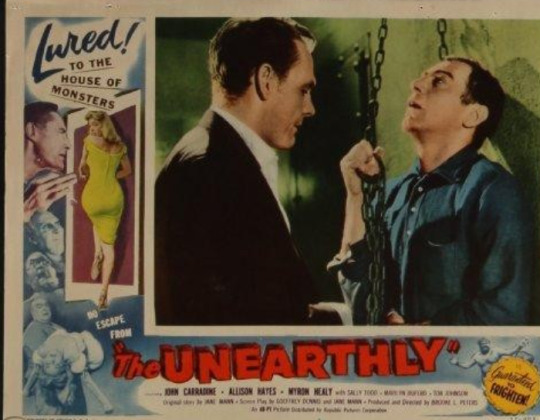

Art Batanides got his first acting start in the 1949-50 KTLA TV series The Armchair Detective. But his first semi-regular role was as a recurring villain in the sci fi television series Rod Brown of the Rocket Rangers. In an interview for Starlog 189, Batanides remembers being followed on the set by one of the extras who would drive him nuts practicing his comedy routines which often involved sound effects like that of a machine gun. It turned out to be comedian Jonathan Winters.
He also did a few cheesy sci fi movies. In the first one titled The Unearthly (1957) he played a good guy trying to stop John Carradine’s evil plot. A few years later, Batanides appears as one of victims of June Talbor aka “The Leech Woman” in the movie of the same name. Both films have been lovingly reviewed in Mystery Science Theater 3000. The actor chuckled during his Starlog interview as he recalled how terrible these were, so bad that he and the other actors had to bite their lips.
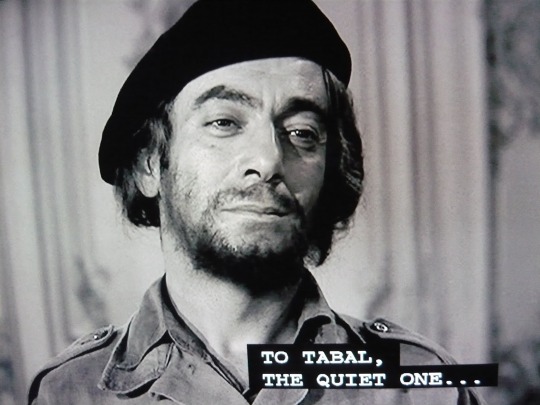
He was cast in two Twilight Zone episodes, “Mr. Denton on Doomsday” and “The Mirror.” In the latter episode, Peter Falk plays a Castro-like revolutionary named Ramos Clemente has a mirror that tells him which of his trusted supporters will attempt to assassinate him. One of his victims is played by Arthur Batanides and is named Tabal, ironically the leader of Clemente’s execution squad. Supposedly Tabal was based on real-life Che Guevera who had played a similar role in Castro’s rise to power.
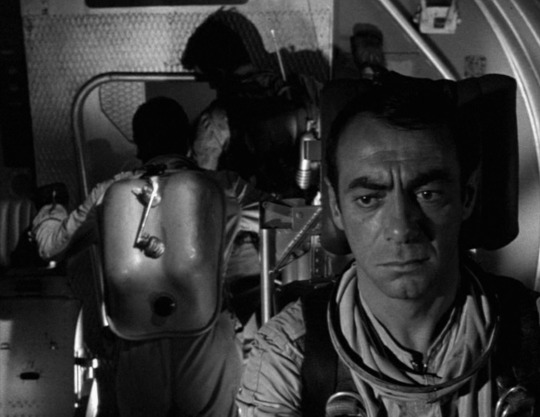
He played a character named Lt. Garvin, one of the astronauts in “Specimen: Unknown” for The Outer Limits along with two of his former acting school friends, Russell Johnson and Richard Jaeckel. The plot involved astronaut/researchers bringing back plants that they discover on the planet. Unknown to them, the plants soon begin to emit spores and then a deadly gas which threatens the crew. The spores allow them to multiply rapidly. Does this plot sound familiar to Trek fans? Hmmm.....
There are several other Star Trek connections as well. 1) this episode was directed by Gerd Oswald who would go on to direct “The Alternative Factor” and “The Conscience of the King.” 2) Robert Justman was the assistant director on the set just as he was for the first two Star Trek pilots. He eventually wound up as the associate producer and then finally the co-producer. 3) Bob Johnson and Vic Perrin both did voice-overs for this episode and also provided the same on several episodes of Star Trek. Vic was most famous as the Control Voice which was heard at the beginning of every show. 4) Finally, Fred Phillips was the makeup supervisor for this episode and performed the same duty on all three seasons of Star Trek.
“Specimen: Unknown” earned the highest ratings of the first season. But Batanides bemoaned the fact that the whole show had a low budget and that none of the astronaut suits matched. A complaint we Star Trek fans are familiar with.

In The Time Tunnel’s episode titled “Attack of the Barbarians” Batanides was Batu Khan, Kubla Khan’s grandson. The actor has quite vivid memories of this character because he had to sit in the makeup chair for two hours and then they covered his head with a stretchy cloth so he appeared bald. But if you look at the results above, it appears the makeup artists did a wonderful job.
Star Trek connections abound in this episode as well. Of course Lee Meriwether (Dr. Ann McGregor) would appear with him a few years later as Losira in “That Which Survives.” Another major character, Lt. General Haywood Kirk, was played by Whit Bissell, who also played the beleaguered station manager Lurry in “The Trouble with Tribbles.”
There were also connections with two stunt people. Charlie Picerni was James Darren’s stunt double on the show itself (his brother Paul played a Mongol warrior in this episode). We saw him on Star Trek as a security guard in “Day of the Dove.” David Sharpe also performed stunts not only in this episode of The Time Tunnel, but he was also James Daly’s stunt double in “Requiem for Methusaleh” and was a stuntman in “Day of the Dove.”

Batanides next appeared as a caveman leader named Rongah in “The Space Primevals,” a 1967 episode of Lost in Space. Art remembers having to wear the animal skin and wig and doing an impromptu caveman dance in one scene. Rongah and his people worship a giant computer named Protineus. The machine convinces the cave people that the humans are a danger to their people, ordering them to lock up Major West and Dr. Smith. It becomes clear that Protineus is acting much like Landru in “Return of the Archons.” There is even a scene where The Robot tries to confound Protineus by performing a series of magic tricks, much like Captain Kirk confounding computers in many episodes.
Not many other Star Trek Connections here except for Sandy Gimpel (a Talosian in “The Cage”) as Will Robinson’s stunt double and Fred Steiner’s music.

For the most part, Art was not too enthusiastic about taking roles in science fiction, despite the number of them in which he appeared. He was afraid it was going to wind up getting him typecast. When Freiberger offered him the part of D’Amato in “That Which Survives,” he was pleasantly surprised that his character was not the heavy nor did he have to do anything ridiculous like jump around the stage doing a caveman dance. D’Amato was pretty much a straight up role and Batanides enjoyed doing the show. Ironically, the role of D’Amato is one of the two roles for which he is most remembered.
Asked what he remembered most about the episode, Batanides recalled they had the planet set on rollers to make it easier to simulate the earthquakes that rocked the planet. He was impressed with all the cast members, especially Leonard Nimoy.
Trivia - During the late 1940s, Batanides shared a rented house with Fred Freiberger while they were both taking classes at the Actor’s Studio. It was Fred who hired his friend for the part of D’Amato in the third season of Star Trek. But Fred also helped him land a few roles in another show, The Wild, Wild West. (Freiberger wrote one of the episodes in which Arthur appeared - “The Night of the Dancing Death.”
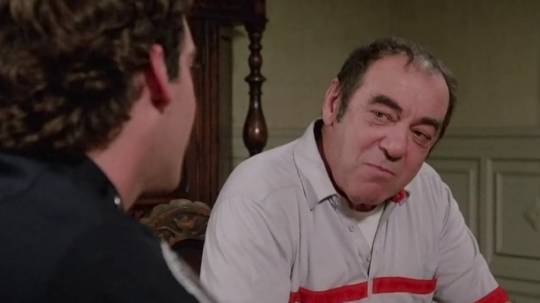
Freiberger was not the only influential friend he had. Over the years, Batanides had worked on many movie and television shows with director Jerry Paris, another friend of his from the Actor’s Lab. Jerry was made director of the first sequel to Police Academy. As he was looking over the script, he noticed a character who had been scratched out. However, he decided it was a great role and called Art to play Mr. Kirkland, father of the Kirkland family.
Batanides today is still most often remembered for his role as Mr. Kirkland and as D’Amato. He retired after doing one last Police Academy movie (City Under Siege) and spent the last ten years of his life doing a few roles but mainly traveling various places with his wife. He died of natural causes in January of 2000.
9 notes
·
View notes
Photo
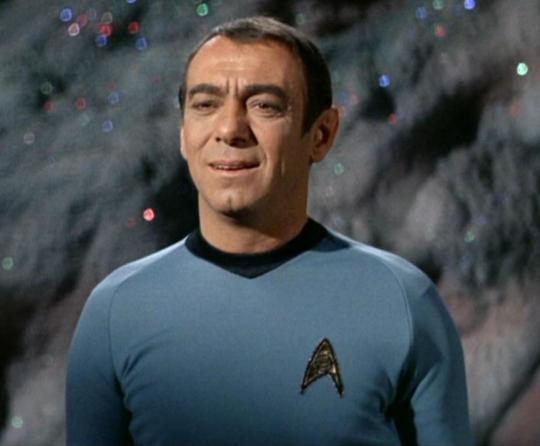
Why is this man smiling?
For one thing, Captain Kirk has asked Lt. D’Amato to join a landing party that is going to explore the planet below and he believes his report may earn him a spot at the Fifth Instellar Geophysical Conference. After all, how many times do you get to explore a young planet of a mere two thousand years with an atmosphere and vegetation suggestive of a much older planet?
And he may be smiling because he’s a blue shirt and he foolishly believes his odds of survival are pretty high. Guess no one told him about Sturgeon and Greene in "The Man Trap."
And there is another reason he is smiling.

While he is recording his findings on his tricorder, this beautiful woman appears in front of him. After revealing that she knows his name, rank, specialty and ship, she then tells him “I am for you, Lieutenant D’Amato.” “Lucky me,” he replies.
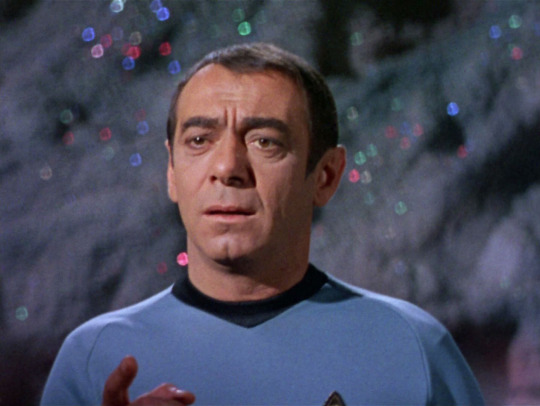
Then suddenly, he stops smiling when he realizes she was the woman who killed the transporter operator just as he was beaming them down. That’s when he stops to check the color of his shirt. Nope, it’s not red but it may as well be. You know he’s toast.

Gives new meaning to the phrase “he died with his boots on.”
So, after a search, the rest of the landing party finally locate D’Amato. Captain Kirk in vain tries to at least give the man a decent burial but two attempts to blast out a spot with his laser fails.
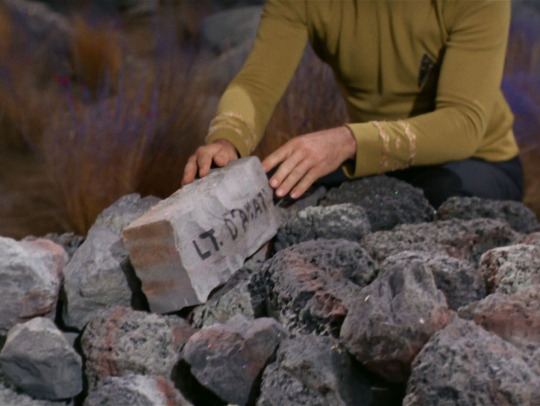
D’Amato’s body is covered with rocks and topped with a marker. Interesting that Captain Kirk managed to find a somewhat rectangular rock among all those other irregularly shaped ones. And that he evidently found a way to print Lt. D’Amato’s name in big block letters. Well, I guess that is why he’s the captain.
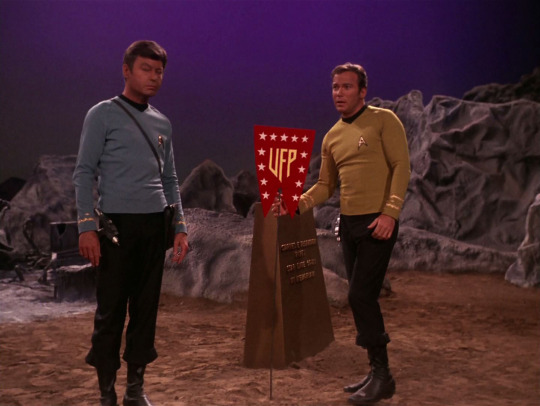
Another interesting note - this is the third time a member of the crew was buried on the planet where he died. There was also a fourth burial shown in the series. When Captain Kirk, Spock, and McCoy land on Triacus, one thing they did was to bury the bodies of the research scientists who were the parents of the rotten kids in “And The Children Shall Lead.” Kirk marked each grave with a type of metal plaque that had their names engraved on them. And then he planted a UFP banner in the ground. I am not even going to speculate where he obtained all these items, but I will give the captain credit for honoring the dead.
And I bet you thought we were through with D’Amato, weren’t you? Guess again.
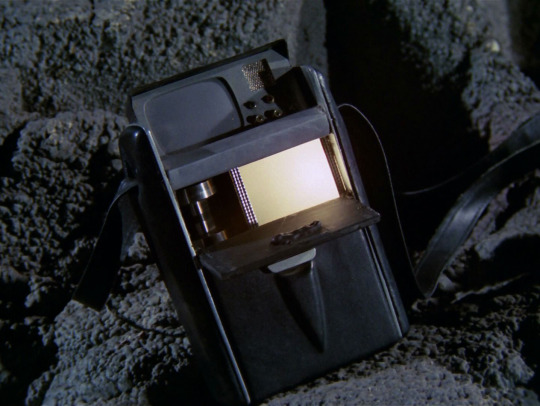
Once they’ve buried D’Amato, Captain Kirk orders Sulu to use the geologist’s tricorder and set it for automatic distress as they each take turns standing watch.
Take a good look at this tricorder. Notice anything? This is not your typical tricorder with several slots on one side so a person can insert a disc to record on and a circular moire pattern on the other. It has only one slot and instead of a moire element on the right, there is a second screen. Unofficially, this is referred to as a geological tricorder and this episode seems to be the only instance in which it is seen in The Original Series.
If you want, you can still find a pretty good replica out there. Could be a bit dear tho. https://www.walmart.com/ip/Star-Trek-The-Original-Series-Geological-Tricorder-Replica/928086
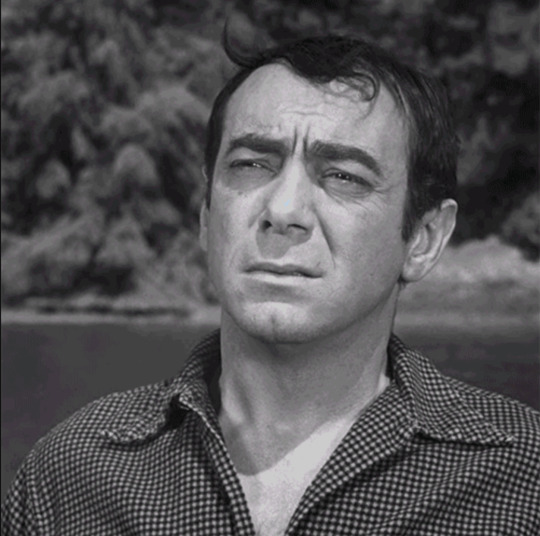
Now that we've discussed D'Amato's tragic fate along with some interesting factoids, we will be back in a few days with the background of the actor who portrayed him - character actor Arthur Batanides. Please be sure to join us on Sunday!
20 notes
·
View notes
Photo

It’s one of those sad truths in Hollywood that an actor often doesn’t get the role he auditions for. But occasionally, losing one part may open the door to others. As an example, let’s look at the actors who auditioned for “The Corbomite Maneuver.” We already know Anthony Call got the part of Bailey.

Two actors were given roles in two other episodes of Star Trek. Bruce Mars appeared as Finnegan in “Shore Leave” and a police officer in “Tomorrow was Yesterday.” Stewart Moss also appeared twice in Star Trek, once as Joe Tormolen in “The Naked Time” and once as Hanar in “By Any Other Name.”
Bruce’s screen acting career only lasted about four years but he had fairly steady work during that time. And actually, he may have stayed in acting longer but in 1969 he became Brother Paramananda, a monk in a spiritual group known as the Self-Realization Fellowship. According to Wikipedia, he spoke to Elvis Presley several times during his years in the Fellowship who (possibly with some envy) told him he had definitely made the correct decision.
Stewart Moss had a bit more success in Hollywood, appearing in several movies and earning acting roles in quite a number of television series, including as the recurring character of Olsen in Hogan’s Heroes. Even though his last screen appearance was in 1993, he turned to directing plays in the theater and writing.

Many declare that Jonathan Lippe appeared as a crewman working in a corridor of the Enterprise in “The Corbomite Maneuver” as a consolation for not getting the part. But the actor himself has denied it many times. And even though he never had a standout role, Lippe managed a decent living from 1963 until the early nineties. Maybe he never appeared on Star Trek, but as Jonathan Goldman, he portrayed “The Most Interesting Man in the World” over many years for Dos Equis. Not a bad consolation prize. Much better than playing some nameless redshirt.

Another on the list is George Bochman. Nothing is listed under that name in IMDb but there is a listing for an actor named George Backman. Michael Kmet, creator of the blog Star Trek Fact Check, believes they are one and the same. ( http://startrekfactcheck.blogspot.com/2017/11/the-most-interesting-article-in-world.html) Backman was originally from England but began appearing in a number of plays on both sides of the Atlantic. He is the young man on the right in a 1969 American stage production of Rosencrantz and Guildenstern Are Dead.”
Backman was seen in a 1965 episode of Combat! titled “The Raider.” In the same episode was an actor by the name of George Sawaya. George appeared three times in Star Trek - Chief Humboldt in “The Menagerie, Part 1,” a Klingon soldier in “Errand of Mercy,” and a Klingon crewman in “Day of the Dove.” However, he was not the only Trek actor who appeared in this episode besides George Backman. Leonard Nimoy also had a minor role in this episode. We do not know positively, but think it is highly likely that George Backman is the final actor listed who auditioned for the part of Dave Bailey.
Losing the part of Bailey did not seem hurt George Backman’s career. He was active on the stage before and after “The Corbomite Maneuver” (I found references to him in productions as late as 2001) and he was a drama instructor at the University of California at Santa Barbara in the late 90s. Later in life he began doing parts in Reader’s Theater productions. Backman is also heard on a number of audiobooks as the reader.

But there is one more person on that audition list. John Gabriel had previously auditioned and been hired for the pilot episode of a very popular television series. In fact, it was still running at the time he was auditioning for the part of Bailey in “The Corbomite Maneuver.” So why would he be here?
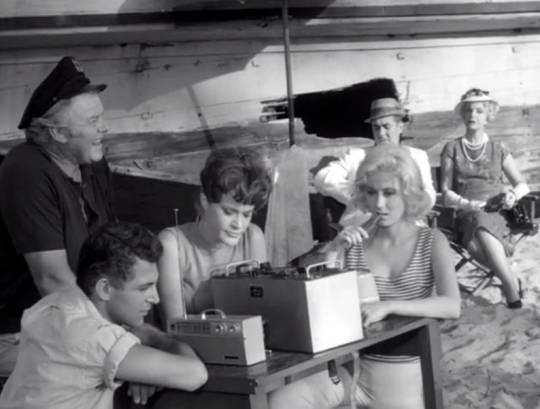
A little background. Many of us are familiar with Gilligan’s Island, but how many of us knew the very first pilot of this show was done in 1963 and helped sell the series (even though it did not air until 1964). Even though two test audiences gave the pilot itself high marks, when asked to rate how well they liked each character, three of them were at the very bottom - Kit Smythe (Ginger), Nancy McCarthy (Bunny), and John Gabriel as The Professor. CBS definitely wanted the show but told Sherwood Schwartz he had to drop those actors.

Even though Sherwood Schwartz tried to soften the blow when he broke the news to John Gabriel by telling him it was because the network thought he looked too young to play the part of a professor, the actor took it hard. ”When my agent told me they were replacing me (in Gilligan), I just sat there and wept,” he recalls. ”But it was the best thing that could have happened.”
And as we know, Russell Johnson was given the part of The Professor and the show lasted for 98 episodes, ending in 1967. So John Gabriel went to work looking for other parts, one of which was Bailey in “The Corbomite Maneuver.” Which he did not get.

But...John Gabriel was right. He did go on to better things. First, Gabriel snagged the first of his soap opera roles, Linc Morrison in Love of Life. After lasting two years in that role, he moved to another recurring role as Teddy Holmes in General Hospital for a year. Then he found another recurring role as sportscaster Andy Rivers, boyfriend to associate producer Mary Richards on the Mary Tyler Moore Show. From 1984 to 1989, he landed the part of Dr . Seneca Beaulac on Ryan’s Hope.
So even though Anthony Call won the part of Dave Bailey in “The Corbomite Maneuver,” that was not the kiss of death for the other actors who auditioned. One left acting, but found his own version of fulfillment and the others went on to have successful careers on the stage and/or on the screen.
9 notes
·
View notes
Photo

And you think you are having a bad year.
51 notes
·
View notes
Photo
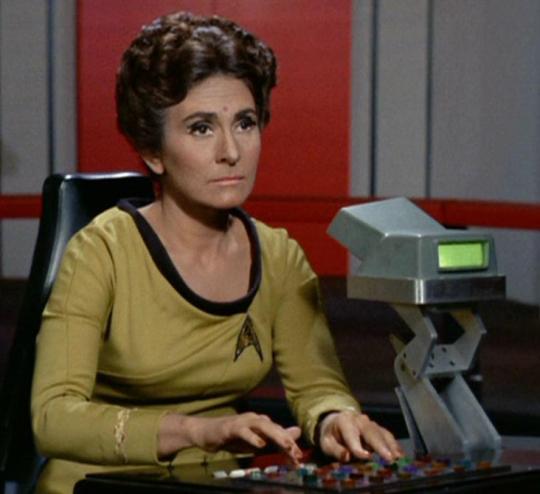
The Original Series is full of one-shot characters who appear briefly in the corridors, rec room, various work areas and on the bridge. Most of us barely take notice of them. But occasionally, one of these characters stands out enough that we would have liked to have known her better, perhaps enough to see her in a few more episodes.
One of these is Lt. Rahda, the command officer who took over the helm for Lt. Sulu when he became part of the landing party in “That Which Survives.” She deserves recognition for being one of only two helmswomen shown during the series - Yeoman Rand once took the station temporarily but that was only in an emergency. And if you notice her bindi (the red spot) in the middle of her forehead, she also is almost certainly the first Hindu character as well. Lt. Rahda is another example of Gene Roddenberry’s dedication to depicting diversity as the norm in the future.
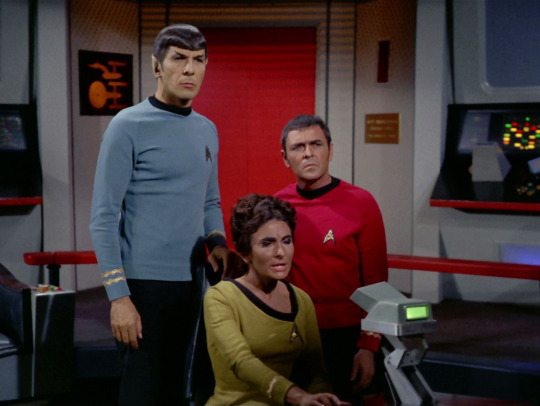
She also provides an important bit of information in this episode. Lt. Rahda is the first to notice that not only isn’t there any sign that the planet on which the landing party is stranded has broken up, despite the turbulence they had all felt earlier. Not only that, but Rahda announces the planet has disappeared and that now the stars they see are not what they should be seeing. Replaying a recording of the stars taken before the turbulence, she then proves that they somehow have been knocked across space nearly a thousand light years from their previous position. This allows Spock to calculate exactly how far away they have been thrown. He then orders Mr. Scott to get them up to Warp 8 and Lt. Rahda to plot a course back to their original position. With that, her part in the episode is pretty much over except for occasional appearances in a bridge shot. It’s a pity we could not have seen her on the bridge at least once or twice more - female officers capable of handling complex tasks such as helm navigation were sorely lacking.
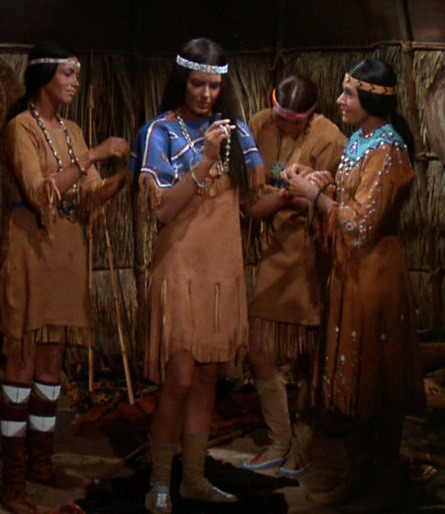
Actually, we saw the actress who played Lt. Rhada in another episode but not as Lt. Rhada. Naomi Pollack was also the young Native American friend who speaks to Miramanee as they prepare for her and Kirok’s marriage ceremony in “The Paradise Syndrome.”
Of course, Naomi Pollack was neither a Hindu nor a Native American. Accurate casting was not usually a concern in the sixties. However even though Gene Roddenberry was not involved in the day to day work on Star Trek, he did write a memo to Fred Freiberger stating his displeasure with the character’s appearance, according to a Trek BBS participant -
"If the woman at the helm is supposed to be Indian, which is not a bad idea, someone goofed badly in makeup and hair style in getting this point out."

Before Star Trek, the actress we know as Naomi Pollack actually had a career as a professional singer. This photo, which appeared in a November issue of The Forwards ( a highly esteemed Jewish-American newspaper), appeared over an article announcing her first performance in New York at the Carnegie Recital Hall.
Under her original name Naomi Newman, she had already performed in jazz concerts and participated in a benefit concert sponsored by two Jewish organizations (her father was Director of the Yiddish Culture Club in Los Angeles). Eventually, she went on tour as a opera soprano singer in Europe with stints in Rome and Paris, performing songs by Mozart and a 20th century composer named Milhaud. During her time in Paris, she met and married American painter Reginald Pollack. Interestingly, you hear his name in a TOS episode. Spock mentions him as the artist of some of the works owned by Flint in “Requiem for Methusaleh.” It’s even possible that he was another one of Flint’s aliases.

At some point, Ms Newman entered the world of acting. According to her resume, she appeared not only on Star Trek but on Ben Casey and The Wild Wild West. And she also had a starring role in one of Hanna Barbera’s few live-action series, Korg: 70,000 B.C. Naomi Newman played Mara, wife of the clan leader named Korg and mother of three children.
This show was intended to show what life was like for a typical Neanderthal family. It was presented in a documentary style and was narrated by Burgess Meredith. Even though it was presented as a children’s Saturday morning program, it was meant to be educational as well. The American Museum of Natural History in New York and the Los Angeles County Museum of Natural History both consulted with the writers to give the show an air of authenticity.
Another piece of Star Trek trivia - the show was directed by Fred Freiberger, who was in charge of The Original Series during the third season, which would have included the two episodes in which Newman appeared.
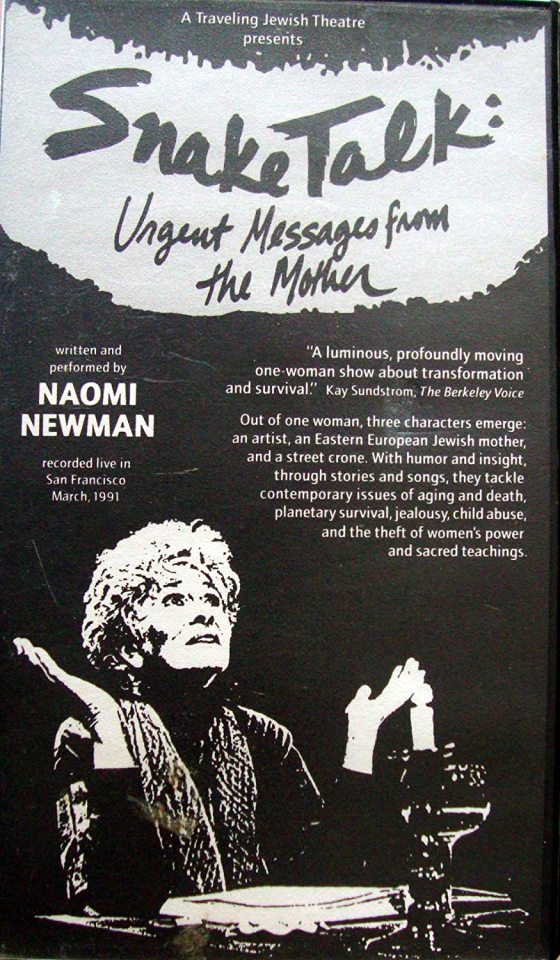
But Naomi Newman is better known for her work on and for the stage than rather than on the screen. She became a co-founder of A Traveling Jewish Theatre and stayed with them for 34 years. Based in San Francisco, the company used theater as experimental exploration of Jewish identity in America. During that time, she served the company as an actress, a director, and a playwright and won awards in all three fields. Unfortunately, the theater company had to close at the end of its 35th season in 2011 because of lack of funding.
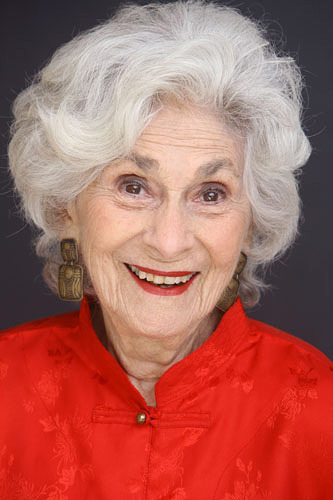
It is difficult to find much more about her but her husband, Reginald Pollack, did allow the Smithsonian to microfilm items documenting her life from 1949 to 1964. These include letters relating to her concerts and singing engagements, some of her own drawings, over 260 personal photos, press releases and clippings, programs and contracts among other things. They can be accessed in the reading room of the Archives of American Art in Washington D.C. And we can add that to what we know about her acting career on both screen and stage. By the way, if you look at her resume on her agency’s website, Newman’s range of skills is quite impressive. https://bit.ly/2F3P8j0
But acting and singing are not her only accomplishments. Newman also had her own well-respected psychotherapy practice. During the 70s and 80s, she was part of the senior staff of The Center for the Healing Arts in Los Angeles. This facility pioneered exploring both the spiritual and psychological aspects of healing.
So perhaps Lt. Rahda was a one-shot character. And her role as Miramanee’s friend only lasted a few minutes. Maybe it is easy to assume that most actors with only a handful of appearances on the screen never achieved any level of success after that. But that certainly doesn’t apply to Naomi Newman. She has made lasting contributions in several fields over the years. Never underestimate the abilities of a Starfleet helmswoman.
#Lt. Rahda#That Which Survives#Naomi Pollack#Naomi Newman#Korg 70000 B.C.#Mara#Concert singer#playwright#director#A Traveling Jewish Theatre
28 notes
·
View notes
Photo
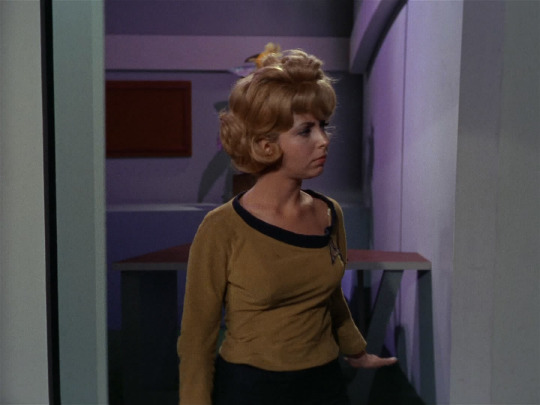

What does this young crew woman in a command uniform from “Charlie X” have in common with Elaine and Robert Johnson in “The Deadly Years”?
(take note of her uniform - one of the last times a crew woman wore slacks)
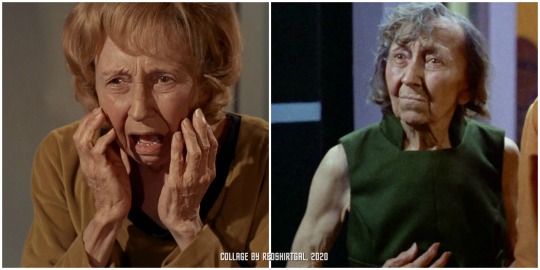
The aged version that Charlie X created and Elaine Johnson were both played by the same actress named Laura Wood.
Regrettably, we do not know the name of the young crew woman Charlie X transformed into the older one.

Ms. Wood had been a model in her younger years but she didn’t seem to show up in movies or television until she was in her fifties. Her first role was in a 1955 episode of Medic titled “And Then There Was Darkness and Then There Was Light: Part 2.” ( She’s the older lady on the right in the photo above)
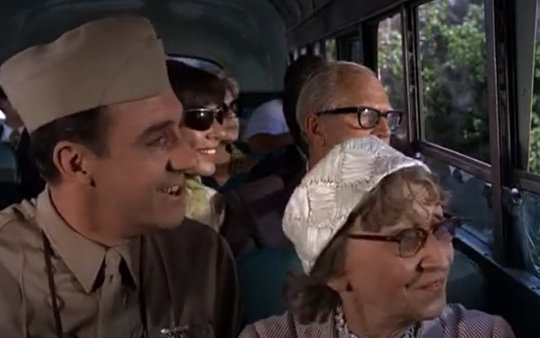
She had a total of 12 roles, including parts in shows like 77 Sunset Strip, The Rebel, and My Three Sons. Laura Wood had an small role in an episode of Gomer Pyle, U.S.M.C. titled “Lies, Lies, Lies” the year before she appeared in Star Trek. She played the passenger seated next to Gomer in the photo.
She was married to Hollywood director Harry Kerwin 1970 - 1975. Laura Wood’s last Hollywood appearance was in a movie directed by her husband, Sweet Bird of Aquarius (1970) in which she played a nudist.
It is a shame we can only locate images of Laura Wood when she was older and not from her days as a model (which was probably from the 1920s since she was born in 1901. And a shame we cannot even find any other information on her. However, no matter what she was in, she seemed to add a little bit of sweetness as a senior citizen in most of her roles.
16 notes
·
View notes